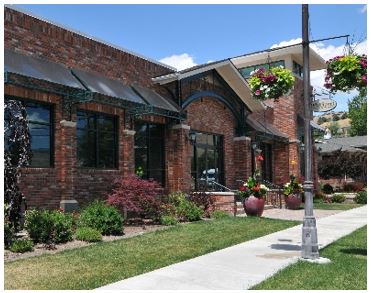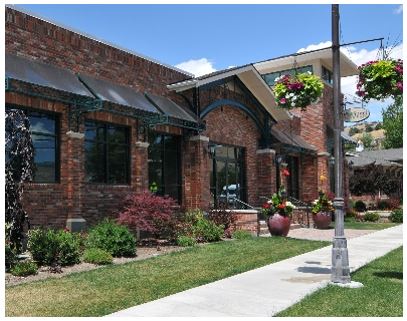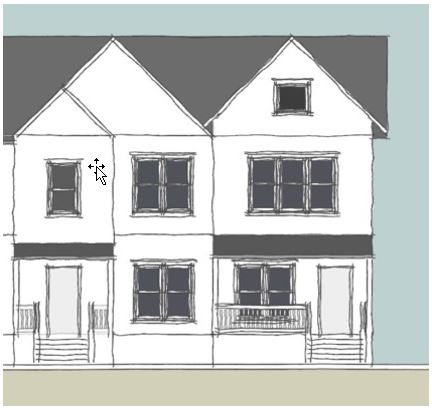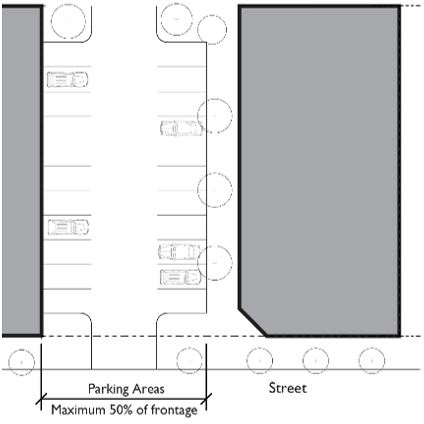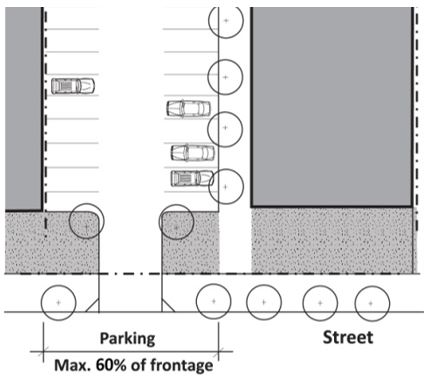Chapter 20.127
DESIGN STANDARDS
Sections:
Article I. Introduction
20.127.020 Applicability and compliance.
20.127.030 Optional design review board project recommendation.
20.127.040 Supplemental submittal requirements.
20.127.050 Pre-submittal design review.
Article II. Block Frontage Standards
20.127.110 Applicability and compliance.
20.127.120 How to use this chapter.
20.127.130 Community design framework maps.
20.127.140 About the transparency standards.
20.127.150 Storefront block frontage standards.
20.127.160 Landscaped block frontage standards.
20.127.170 Varied block frontage standards.
20.127.180 Marine block frontage standards.
20.127.190 Gateway block frontage standards.
20.127.200 Internal roadway storefront frontage standards.
20.127.210 Other block frontage standards.
20.127.220 Trail/park frontage standards.
20.127.230 Special residential frontage standards along sidewalks and internal walkways.
20.127.240 Where a property fronts onto multiple streets/frontage designations.
20.127.250 High visibility street corners.
20.127.260 Community design framework master plan.
Article III. Site Planning Standards
20.127.310 Applicability and compliance.
20.127.320 Relationship to adjacent properties.
20.127.330 Nonmotorized circulation and design.
20.127.340 Vehicular circulation and parking.
20.127.350 On-site open space.
20.127.360 Location and design of service areas and mechanical equipment.
Article IV. Building Design Standards
20.127.410 Applicability and compliance.
20.127.420 Building character.
20.127.430 Building massing and articulation.
20.127.450 Building materials.
20.127.460 Blank wall treatments.
Article I. Introduction
20.127.010 Purpose.
This chapter implements the Port Orchard comprehensive plan. Overall, the purpose of this chapter is to:
(1) Provide clear objectives for those embarking on the planning and design of development projects in Port Orchard.
(2) Preserve and protect the public health, safety, and welfare of the citizens of Port Orchard.
(3) Ensure that new commercial and multi-household development is of high quality and beneficially contributes to Port Orchard’s character.
(4) Upgrade the visual appearance of Port Orchard’s principal vehicular corridors.
(5) Ensure that new developments within existing neighborhoods are compatible with, and enhance the character of, Port Orchard’s neighborhoods.
(6) Promote an increase in walking and bicycling throughout the city.
(7) Enhance the livability of Port Orchard’s residential developments.
(8) Maintain and enhance property values within Port Orchard. (Ord. 008-18 § 2 (Exh. 1)).
20.127.020 Applicability and compliance.
(1) Applicability. The provisions of this chapter apply to all development within Port Orchard, except:
(a) Detached houses, backyard cottages, cottage courts (cottages), side-by-side duplexes, back-to-back duplexes, attached houses, and townhomes as defined in Chapter 20.32 POMC shall not be required to comply with this chapter. Design standards for detached houses, backyard cottages, cottage courts (cottages), side-by-side duplexes, back-to-back duplexes, attached houses, and townhomes are found in Chapter 20.139 POMC. Subdivision design standards are found in Chapter 20.100 POMC.
(b) Properties within the designated Old Clifton Industrial Park. See the figure below for a map clarifying the location of properties which are exempt.
Figure 20.127.020(1)
Old Clifton Industrial Park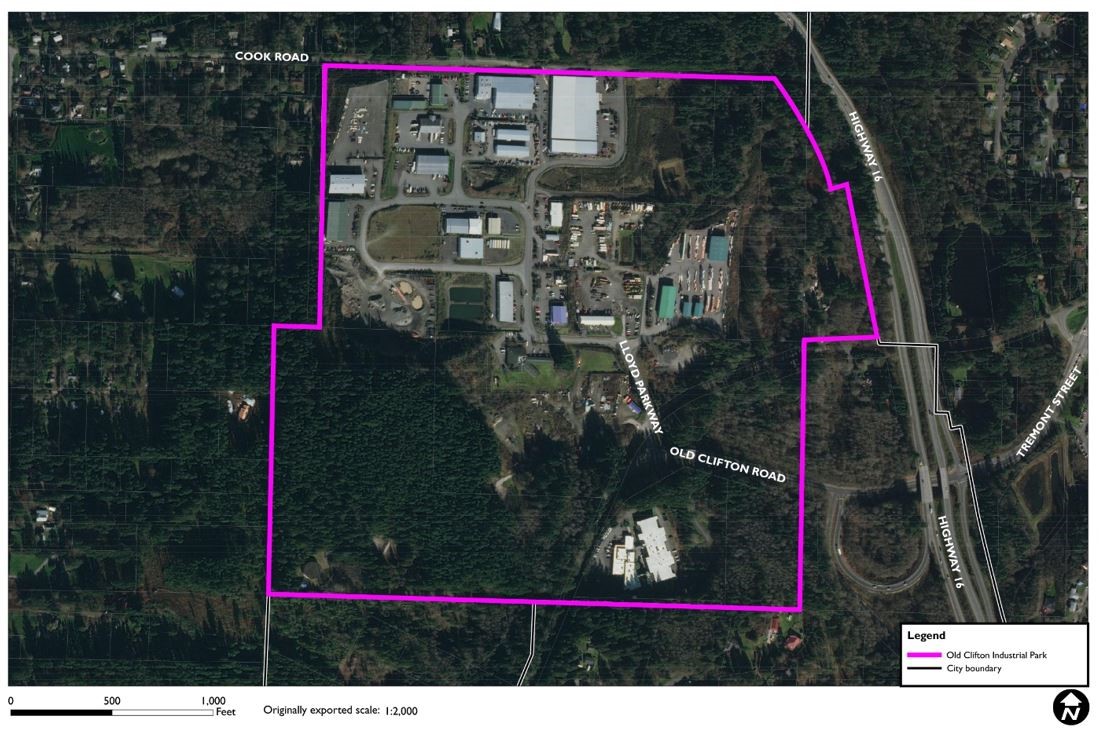
(c) Open-air structures such as pavilions, stages and gazebos for ornamental, performance or recreational use.
(d) The director may waive these provisions in other employment – industrial/office zoned properties where they are screened from view from the public right-of-way and adjacent nonemployment – industrial/office properties by a minimum 20-foot-wide landscaped buffer meeting the requirements of Chapter 20.128 POMC – full screening or by preservation of comparable existing landscaping on the site.
(2) Relationship to Other Codes and Documents. Where provisions of this chapter conflict with provisions in any other section of the Port Orchard design standards, this chapter prevails unless otherwise noted herein.
(3) For building additions, remodels, and site improvements, three different thresholds have been established to gauge how the design standards in this chapter are applied to such projects. See Figure 20.127.020(3) below for examples of site development and the respective types of improvements required under each of the three levels of improvements.
(a) Level I improvements include all exterior remodels, building additions, and/or site improvements that affect the exterior appearance of the building/site or cumulatively increase the gross floor area by up to 20 percent of the gross square footage that existed three years prior to the date of permit issuance. The requirement for such improvements is only that the proposed improvements meet the standards and do not lead to further nonconformance with the standards.
For example, if a property owner decides to replace a building facade’s siding, then the siding must meet the applicable exterior building material standards, but elements such as building articulation (see POMC 20.127.430) would not be required.
(b) Level II improvements include all improvements that cumulatively increase the gross floor area by 20 percent or more, but not greater than 75 percent, of the gross square footage that existed three years prior to the date of permit issuance. All standards that do not relate to repositioning the building or reconfiguring site development apply to Level II improvements. For example, if a property owner of an existing home in the BP zone wants to convert the home to an office and build an addition equaling 45 percent of the current building’s area, then the following elements would apply:
(i) The location and design of the addition/remodel must be consistent with the block frontage standards (see Article II of this chapter), to the extent possible given the location of the existing building. For such developments seeking additions to buildings where an off-street parking location currently does not comply with applicable parking location standards, building additions are allowed provided they do not increase any current nonconformity and generally bring the project closer into conformance with the standards. See Figure 20.127.020(3) for an example of this.
(ii) Comply with applicable site planning and design elements (see Article III of this chapter).
(iii) Comply with all building design provisions of Article IV of this chapter, except architectural scale and materials provisions related to the existing portion of the building where no exterior changes are proposed. The entire building must comply with building elements/details, materials, and blank wall treatment standards of POMC 20.127.440 through 20.127.460.
(iv) The proposed improvements shall comply with the off-street parking, landscaping, and signage provisions of Chapters 20.124, 20.128, and 20.132 POMC.
(c) Level III improvements include all improvements that cumulatively increase the gross floor area by more than 75 percent of the gross square footage that existed three years prior to the date of permit issuance. Such developments must conform to all applicable standards.
Figure 20.127.020(3)
Examples of Improvement Types and Required Compliance
(4) Review for Compliance. Proposals for development, including design standard departure requests, shall be reviewed for consistency with the design standards as found in this chapter in conjunction with every underlying permit application(s) (i.e., building permit, stormwater drainage permit, conditional use permit, binding site plan, etc.) at each stage of the development. The city recognizes that every project is unique and that permits are not always submitted in a single package simultaneously. For instance, a project may require a conditional use permit, building permit, land disturbing activity permit, and stormwater drainage permit. It is common that a building permit application be submitted after site development activities have begun. It is also common to develop building pads for future construction as part of an approved development. (Ord. 056-19 § 22; Ord. 011-19 § 6 (Exh. 3); Ord. 008-18 § 2 (Exh. 1)).
20.127.030 Optional design review board project recommendation.
Applicants for development subject to the design standards contained in this chapter may optionally request that the city’s design review board provide project review and a recommendation on the application.
When requested by the applicant, the design review board shall review permit applications for consistency with this chapter and make a recommendation to the director or hearing examiner, as appropriate to the permit type, who shall give substantial weight to the recommendation of the design review board as long as that recommendation does not conflict with the provisions of this chapter and is consistent with its purposes. Requests for optional design review board project recommendations shall be made at the time of permit application submittal. (Ord. 008-18 § 2 (Exh. 1)).
20.127.040 Supplemental submittal requirements.
A preapplication meeting is strongly recommended to determine which of the below listed supplemental application materials are needed for a specific development in order to determine compliance with the design standards. Applications subject to review under this chapter may be deemed incomplete if they are missing any of the following materials, as needed to determine compliance with the design standards:
(1) Block Frontage Standards.
(a) Identification of the block frontage type(s) applicable to the development.
(b) A site plan and/or other plans illustrating proposed improvements and how the block frontage standards are being met, including (where applicable):
(i) Building envelope location and setbacks/dimensions.
(ii) Site elevation/topography at minimum two-foot intervals.
(iii) Parking location and vehicular access design.
(iv) Percentage of street frontage that is occupied by parking areas and garage entries.
(v) Weather protection elements and dimensions/percentages.
(vi) Facade transparency elements and dimensions/percentages.
(vii) Storefront interior dimensions, including floor to ceiling height and storefront depth.
(viii) Landscaping elements (common or scientific name and size) and design (layout and location).
(ix) Right-of-way improvements and dimensions (including planting strip and sidewalk).
(x) Undeveloped areas, including critical areas and associated buffers).
(2) Site Planning Standards. A site plan and/or other plans illustrating proposed improvements and how the site planning standards are being met, including (where applicable):
(a) Building envelope location and setbacks/dimensions.
(b) Site elevation/topography at minimum two-foot intervals.
(c) Building elevations of all facades, including the location of doors, windows, and balconies.
(d) The location and height of adjacent structures within 25 feet of the property proposed for development.
(e) Nonmotorized circulation elements, including materials, dimensions, and necessary details.
(f) Parking location and vehicular access design, including materials, curb edge, lane configurations, dimensions, and other relevant details to support compliance.
(g) Existing and proposed pedestrian-oriented space, usable residential open space, and other recreational features, including design elements, materials, and necessary details.
(h) Location, design, and configuration of service areas and mechanical equipment.
(i) Landscaping elements (common or scientific name and size) and design (layout and location).
(j) Right-of-way improvements and dimensions (including planting strip and sidewalk).
(3) Building Design Standards. Graphics illustrating proposed improvements and how the building design standards are being met, including (where applicable):
(a) Building elevations showing:
(i) Exterior materials.
(ii) Doors and windows and associated design details.
(iii) Roofline design and dimensions.
(iv) Details on proposed exterior materials and finish.
(v) Blank wall treatment details.
(b) Building plan view drawings showing:
(i) Facade articulation and dimensions.
(ii) Entry locations and design.
(c) Three dimensional graphics emphasizing:
(i) Building massing and articulation.
(ii) How the development (proposed improvements) fit within the surrounding context. The graphic must illustrate the general massing of buildings within 50 feet of the site.
(4) Departures. If any departures are requested, such elements must be clearly identified in the above materials. Documentation to support how such proposed departures meet the applicable approval criteria must be included. (Ord. 008-18 § 2 (Exh. 1)).
20.127.050 Pre-submittal design review.
(1) It is the city’s intent to offer a pre-submittal design review process to allow applicants to vet their building and site designs prior to completing full architectural and engineering construction plans required for technical plan review and permit application submittal. Applicants seeking pre-submittal design review may request that a preliminary review of conceptual site and/or building plans be conducted by the director to evaluate consistency with the design standards found in this chapter.
(2) Anyone seeking pre-submittal design review shall:
(a) Complete an application form.
(b) Pay the appropriate fee as set by resolution.
(c) Submit conceptual plans along with the materials listed in POMC 20.127.040 to the department of community development.
(3) The director shall review the request for pre-submittal design review and provide a pre-submittal design review letter and/or marked up plans describing which portions of the conceptual design meet and do not meet the design standards.
(4) Any letter and/or marked up plans generated in a pre-submittal design review shall not be considered a final decision and are only intended to assist an applicant in the preparation of complete application materials. (Ord. 008-18 § 2 (Exh. 1)).
20.127.060 Departures.
(1) Overview and Purpose. This chapter provides for a number of specific departure opportunities to development standards. For brevity in tables, departure opportunities are noted with the ➲ symbol. The purpose of this section is to provide applicants with the option of proposing alternative design treatments, provided such departures meet the “purpose” of the particular standard and any additional departure criteria set forth for the particular departure opportunity.
(2) Departures Are Voluntary. This provision allows the flexibility for applicants to propose alternative designs on a voluntary basis as provided herein.
(3) Variances versus Departures. Variances, as set forth in Chapter 20.28 POMC, require conditions in place on the property, not created by the property owner, that create practical difficulties or unnecessary hardships in complying with the applicable development regulations. Such conditions are not necessary in order to qualify for departures, which can be proposed as an alternative to complying with specific design standards in this chapter provided they comply with approval criteria listed in subsection (6) of this section.
(4) Applicability. Departure opportunities are available only to those specific standards that allow for departures.
(5) Review Procedures. Departure requests are to be reviewed in conjunction with the underlying development permit and processed as set forth in POMC 20.127.020(1) and Chapters 20.22, 20.24 and 20.25 POMC.
(6) Approval Criteria. Project applicants must successfully demonstrate to the reviewing authority (the director or hearing examiner, as appropriate to the permit type) how the proposed departure meets the purpose(s) of the standard and other applicable departure criteria that apply to the specific standard.
(7) Documentation. For each departure approved, the reviewing authority must make findings that document the manner in which the departure satisfies the approval criteria in subsection (6) of this section. The findings are to be maintained with project application records for the purpose of providing consistency in decision-making by the city. (Ord. 008-18 § 2 (Exh. 1)).
Article II. Block Frontage Standards
20.127.100 Purpose.
(1) To provide standards to implement the comprehensive plan and applicable adopted sub-area plans.
(2) To design sites and orient buildings with an emphasis on compatible development and creating a comfortable walking environment.
(3) To provide standards that recognize the need for a system of streets and block frontages. (Ord. 008-18 § 2 (Exh. 1)).
20.127.110 Applicability and compliance.
The provisions of this article apply to all development within Port Orchard, except detached single-family and two-family (duplex) dwellings in any configuration. (Single-family and duplex design standards are found in Chapter 20.139 POMC.) Also:
(1) Applicability.
(a) See POMC 20.127.020(1) for clarification on the types of development to which these standards apply.
(b) See POMC 20.127.020(2) for the relationship between the provisions in this article and other documents and codes.
(c) See POMC 20.127.020(3) for the application of building additions and remodels and site improvements.
(2) The default block frontage for new streets in commercial and mixed use zones is other (POMC 20.127.210) unless a designation is already provided. The default block frontage for undesignated streets within annexed land is varied (POMC 20.127.170).
(3) The block frontage designations apply to development on both sides of the street except where otherwise specified on the maps. For example, on a street with two designations, the designation on the east side of the street applies to properties on the east side of the street. (Ord. 008-18 § 2 (Exh. 1)).
20.127.120 How to use this chapter.
(1) About the Maps. The maps together with the block frontage standards in POMC 20.127.150 through 20.127.250 guide the look and feel of development in commercial and multi-household areas throughout Port Orchard when viewed from the street. The provisions herein recognize that there is a hierarchy of different streets and block frontage types ranging from the pedestrian-oriented storefronts to arterial streets/frontages that warrant greater flexibility in the design of frontages.
The block frontage standards address site planning and building design elements including:
(a) Building location and orientation.
(b) Parking lot location.
(c) Window transparency.
(d) Weather protection.
(e) Landscaping.
The community design framework maps also identify high visibility street corner sites that warrant special design treatment. Refer to POMC 20.127.250 for high visibility street corner requirements.
(2) Block frontage standards for individual properties depend on the type of street properties front onto. Thus, consider the following steps in using this article:
(a) Go to the maps in POMC 20.127.130 to find the property and the block frontage type designation for the street or streets fronting the property. For properties in residential zones, the standards for landscaped block frontages apply (POMC 20.127.160). For properties that front onto multiple streets, see POMC 20.127.240.
(b) Table 20.127.120(2) summarizes standards for each of the designated block frontage types. Go to the appropriate section in this article for the detailed and applicable block frontage standards for applicable block frontage type designation.
|
|
Design Cross Section Example |
Parking Location |
Other Key Provisions |
|---|---|---|---|
|
Storefront |
|
• Surface parking lots shall be located to the rear, below, or above storefronts. Parking on the side and front of buildings is prohibited |
• Special facade transparency and weather protection provisions • Minimum commercial space depth • No ground floor residential uses except lobbies for upper level units |
|
Landscape |
|
• Parking is preferred to the rear of the building, but is allowed on the side. For multi-building developments, no more than 50 percent of the street frontage may be occupied by parking and drive aisles. Parking in front is prohibited |
• Landscaping to soften facades, screen blank wall surfaces, and screen parking • Provide minimum facade transparency for nonresidential uses (variable depending on building setback) • Minimum facade transparency for residential buildings |
|
Varied |
Storefront or Landscape |
||
|
Marine |
Storefront or Landscape |
• Parking is preferred to the side, above, or below buildings. No more than 50 percent of the street frontage may occupied by parking and drive aisles. However, the city recognizes the challenges of developing waterfront properties as well as the limitations created in the shoreline master program. Therefore, departures to allow parking to be located at the front of buildings (between the building and the street) may be approved provided design features successfully mitigate the visual impacts of the parking area on the streetscape |
|
|
Gateway |
|
• No parking lot location standards, except that a 10-foot buffer of landscaping between the street and off-street parking areas • For multi-building developments, surface and structured parking areas (ground floor) are limited to no more than 60 percent of the street frontage |
• Minimum building setback is 25 feet • At least one building entrance must be visible and accessible from the street |
|
Other |
Storefront or Landscape |
• No parking lot location standards, except that a 10-foot buffer of landscaping between the street and off-street parking areas |
• Special facade transparency and weather protection provisions • At least one building entrance must be visible and accessible from the street |
(3) Changes to the block frontage designation for new and existing streets may be made through the following procedures:
(a) Text amendment per Chapter 20.06 POMC, Code Amendments.
(b) Community design framework master plan per POMC 20.127.260. (Ord. 008-18 § 2 (Exh. 1)).
20.127.130 Community design framework maps.
(1) Figure 20.127.130 below is an overview map of the applicable planning areas within Port Orchard. Examine the map to determine which map or figure relates to individual properties.
(2) Figures 20.127.130(1) through (16) include community design framework maps for applicable mixed use and nonresidential zones throughout Port Orchard.
Figure 20.127.130
Port Orchard Community Design Framework Maps Index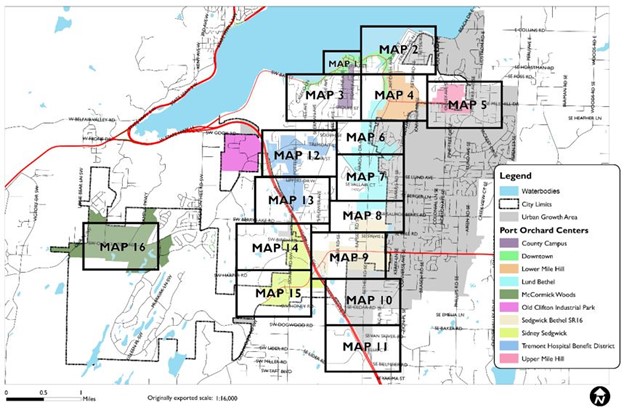
Figure 20.127.130(1)
Map #1 – Downtown West
Figure 20.127.130(2)
Map #2 – Downtown East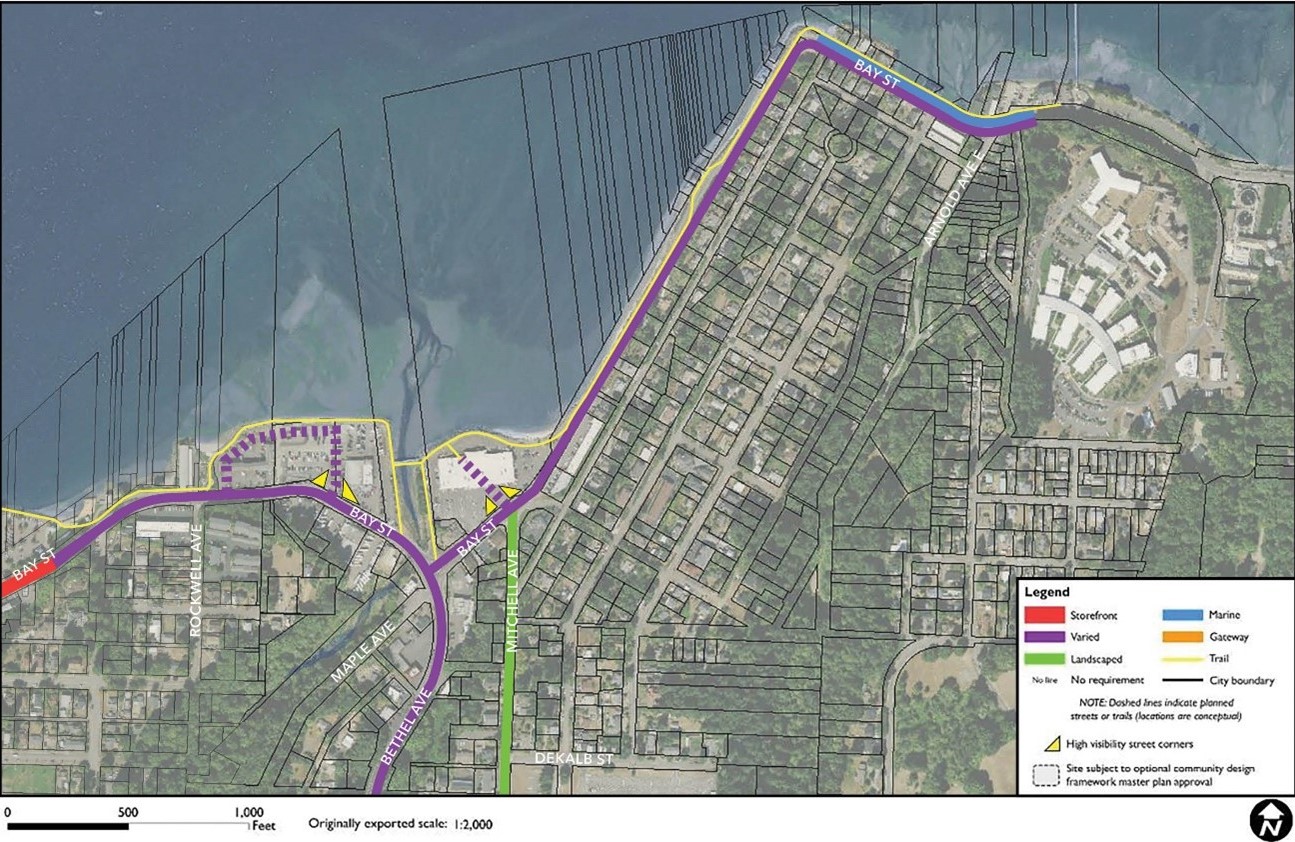
Figure 20.127.130(3)
Map #3 – County Campus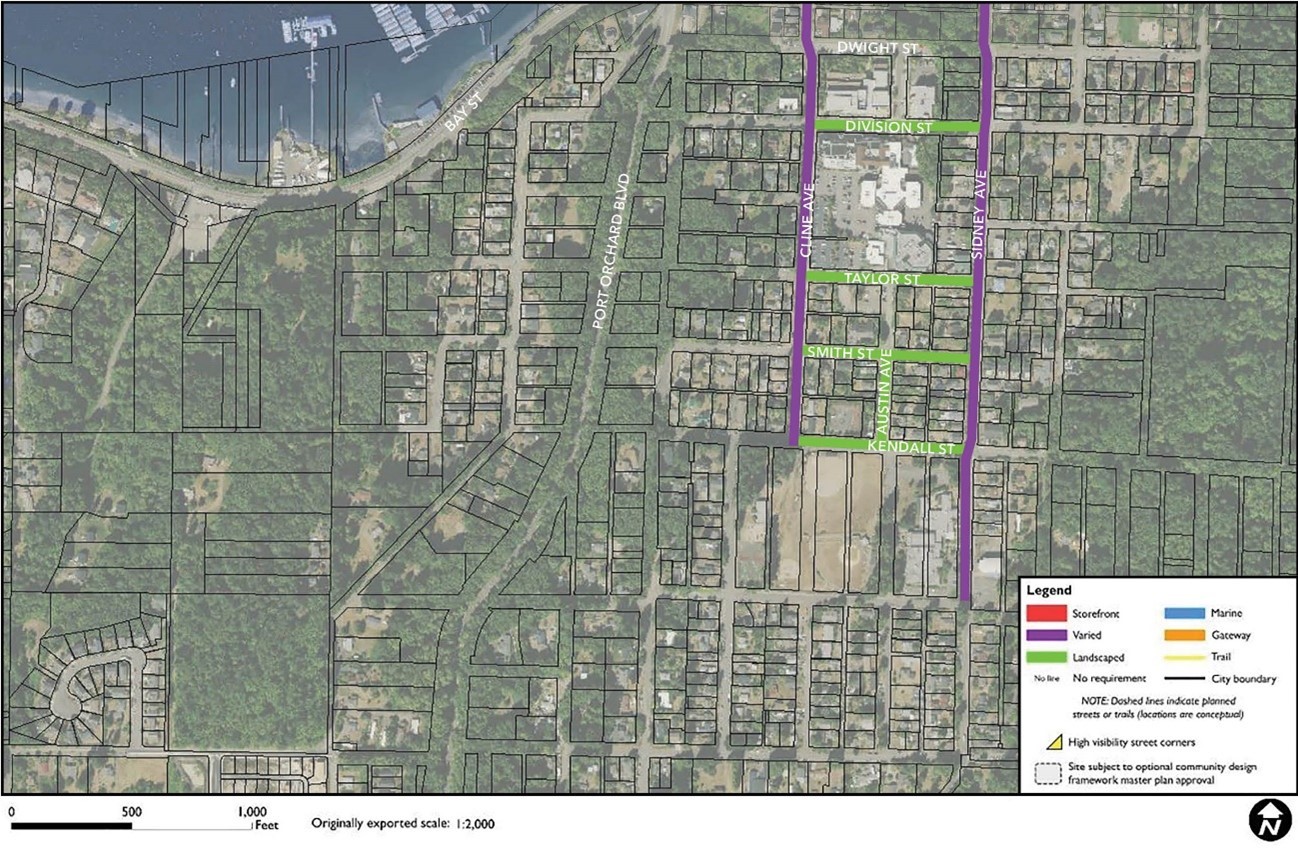
Figure 20.127.130(4)
Map #4 – Lower Mile Hill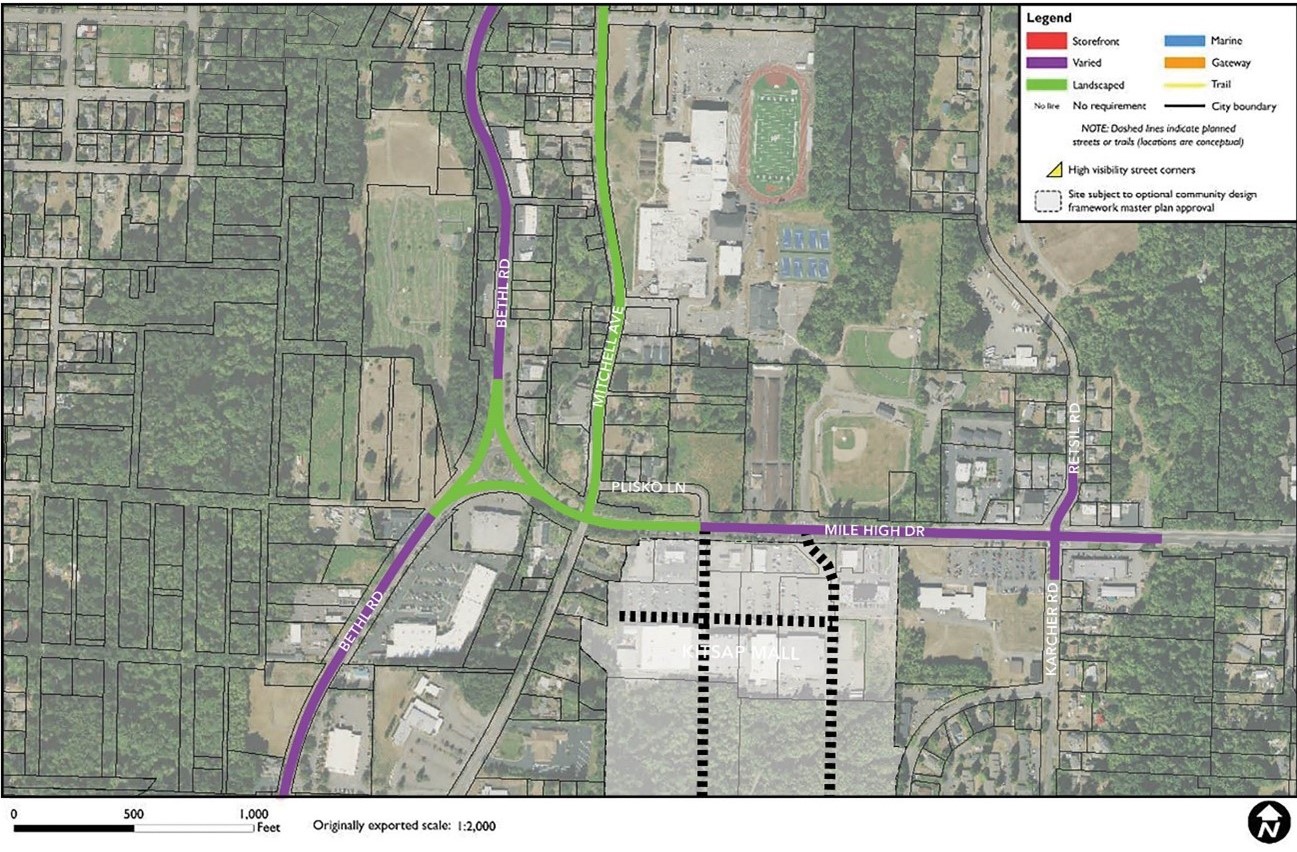
Figure 20.127.130(5)
Map #5 – Upper Mile Hill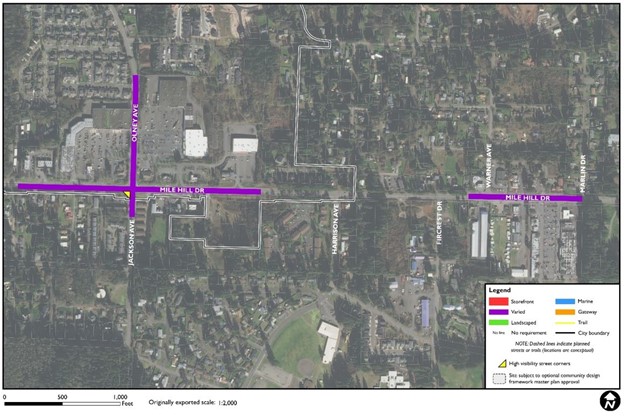
Figure 20.127.130(6)
Map #6 – Bethel North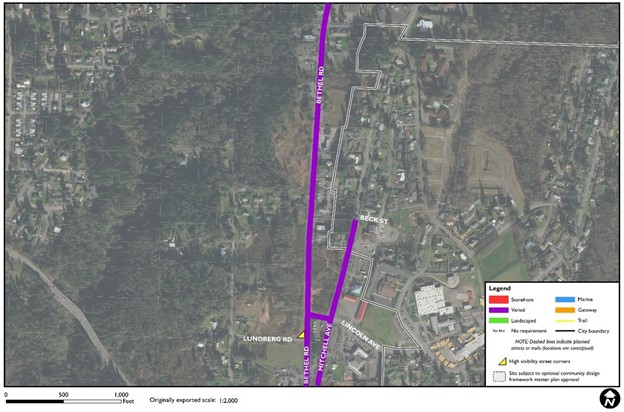
Figure 20.127.130(7)
Map #7 – Lund Bethel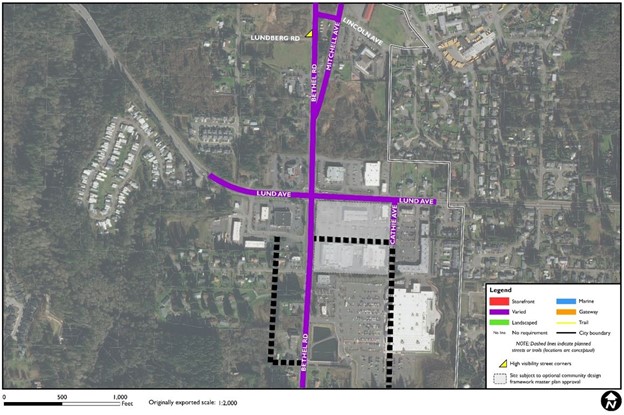
Figure 20.127.130(8)
Map #8 – Bethel South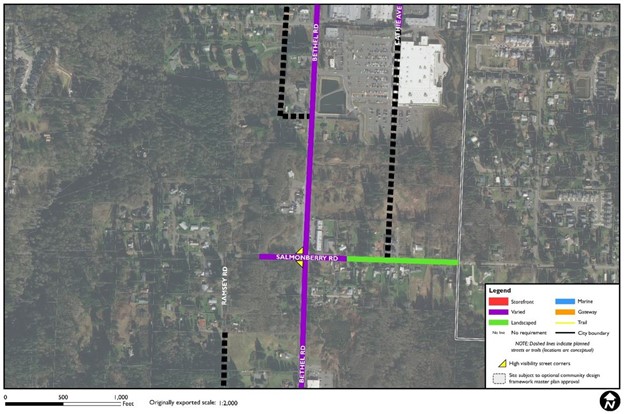
Figure 20.127.130(9)
Map #9 – Sedgwick Bethel SR16
Figure 20.127.130(10)
Map #10 – Bethel Cedar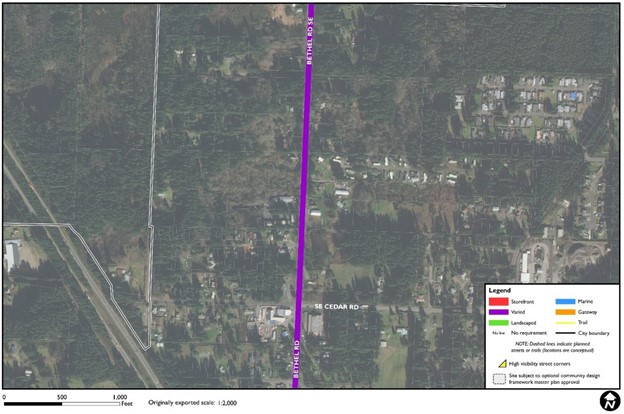
Figure 20.127.130(11)
Map #11 – Bethel Lider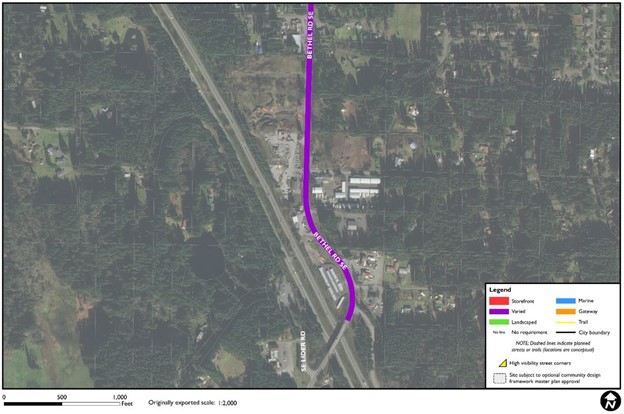
Figure 20.127.130(12)
Map #12 – Tremont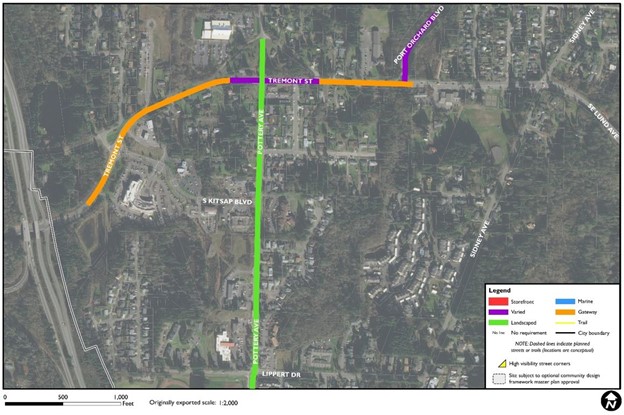
Figure 20.127.130(13)
Map #13 – Cedar Heights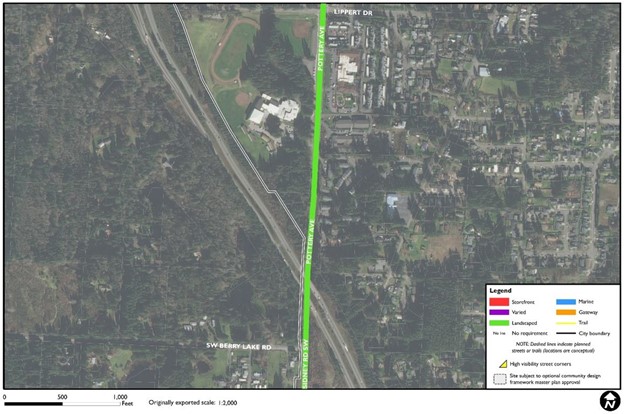
Figure 20.127.130(14)
Map #14 – Sidney Glen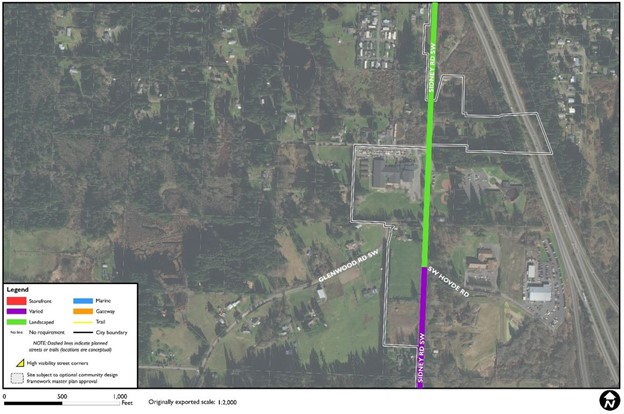
Figure 20.127.130(15)
Map #15 – Sidney Sedgwick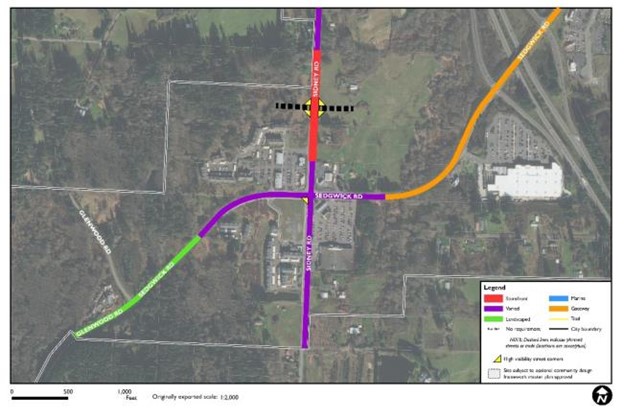
Figure 20.127.130(16)
Map #16 – McCormick Woods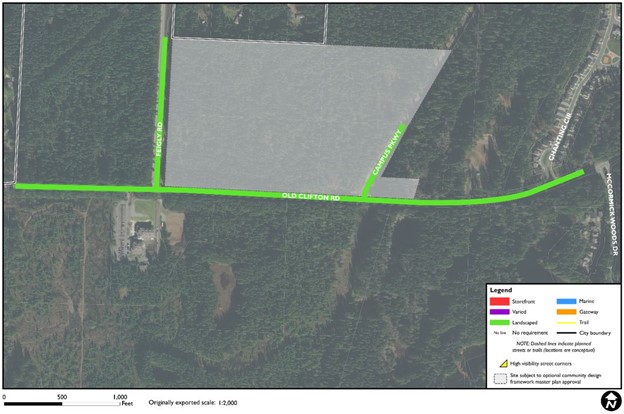
(Ord. 030-21 § 13 (Exh. 5); Ord. 028-20 § 7; Ord. 008-18 § 2 (Exh. 1)).
20.127.140 About the transparency standards.
All block frontage designations contain distinct minimum facade transparency standards. The purpose of these standards are to maintain “eyes on the street” for safety and create a welcoming pedestrian environment. Table 20.127.140 below includes details in how they are measured.
|
Transparency Zones |
||
|
Storefront |
Ground floor nonresidential and nonstorefront |
Residential buildings and residential portions of mixed use buildings |
|
|
|
|
|
The transparency zone is on the ground floor between 30 inches and 10 feet above sidewalk grade |
The transparency zone is between 30 inches and 8 feet above grade |
All vertical surfaces of the facade are used in the calculations |
|
Other Transparency Provisions |
||
|
Windows must be transparent Ground level window area for storefronts and other nonresidential uses that is covered, frosted, or perforated in any manner that obscures visibility into the building must not count as transparent window area. Exception: Window signs conforming with POMC 20.132.280 may be counted as transparent window area provided the areas generally around the sign are transparent. |
|
|
|
Display windows Display window may be used for up to 50 percent of nonresidential transparency requirements provided they are at least 30 inches deep and allow changeable displays. Tack-on display cases as in the far right example don’t qualify as transparent window area. |
|
|
|
Integrated display windows |
Tack-on display cases |
|
|
Structured parking facilities Where structured parking facilities occupy a portion of the facade, any openings simulating windows may be used to help comply with transparency requirements. |
|
|
|
Parking garage with windows |
Parking garage without windows |
|
(Ord. 008-18 § 2 (Exh. 1)).
20.127.150 Storefront block frontage standards.
(1) Description/Purpose. Storefront block frontages are the most vibrant and active shopping and dining areas within the city and serve the purpose of attracting pedestrians to enliven the streetscape. Blocks designated as storefront blocks include continuous storefronts placed along the sidewalk edge with small scale shops and/or frequent business entries.
Figure 20.127.150(1)
(2) Standards. All development as set forth in POMC 20.127.130 on sites containing a storefront block frontage designation must comply with the following standards (on applicable block frontages):
|
Element |
Standards |
Examples and Notes |
|---|---|---|
|
Ground floor |
|
|
|
Land use |
Nonresidential uses, except for lobbies associated with residential or hotel/motel uses on upper floors. |
|
|
Floor to ceiling height |
Refer to building type (applies to new buildings only). |
|
|
Retail space depth |
20 feet minimum (applies to new buildings only). ⇐ |
|
|
Building placement |
Required at front property line/back edge of sidewalk. Additional setbacks are allowed for widened sidewalks, pedestrian-oriented space (POMC 20.127.350(4)), or where additional future right-of-way acquisition is planned by the city. |
|
|
Building entrances |
Must face the street. For corner buildings, entrances may face the street corner. |
|
|
Facade transparency |
60 percent minimum. ⇐ |
Also see POMC 20.127.140 for additional clarification on transparency standards. |
|
Weather protection |
Weather protection with 8 to 15 feet vertical clearance at least 6 feet in minimum depth along at least 80 percent of facade. ⇐ Retractable awnings may be used to meet these requirements. Weather protection must not obstruct utility poles or street trees. Weather protection shall comply with WSDOT standards for setback from the face of the curb and may have the effect of reducing the minimum weather protection depth. |
For downtown properties on Bay Street and adjacent to the city-owned marquee, new development may utilize the existing marquee (subject to approval by the public works director) or new independent weather protection to meet this provision. |
|
Parking location Also see Chapter 20.124 POMC for related parking requirements |
New surface or ground level parking areas must be placed to the side or rear of structures and are limited to 60 feet of street frontage. ⇐ Provide a 6-foot minimum buffer of landscaping between the street and off-street parking areas meeting the standards of Chapter 20.128 POMC. ⇐ |
|
|
Sidewalk width |
12 feet minimum between curb edge and storefront, including a minimum walking surface width of 8 feet and a clear/buffer zone with street trees. ⇐ |
|
(3) Departure Criteria. Departures from the above standards that feature the ⇐ symbol will be considered by the reviewing authority (the director or hearing examiner, as appropriate), provided the alternative proposal meets the purpose of the standards, plus the following criteria:
(a) Retail Space Depth. Reduced depths will be considered where the applicant can successfully demonstrate the proposed alternative design and configuration of the space is viable for a variety of permitted retail uses;
(b) Facade Transparency. The proposed alternative design treatment of facade area between ground level windows provides visual interest to the pedestrian and mitigates impacts of any blank wall areas. No less than 40 percent of the facade between 30 inches and 10 feet above the sidewalk may be approved with a departure;
(c) Weather Protection. Other proposed alternative design treatments must provide equivalent weather protection benefits;
(d) Parking Location. There must be an acceptable tradeoff in terms of the amount and quality of storefront area that is integrated with the development and the applicable parking location departure. Plus, the alternative must include design features to successfully mitigate the visual impact of additional parking areas along designated storefront streets; and
(e) Sidewalk Width. Alternative designs may be considered where topographical challenges exist. Alternative designs must be able to accommodate safe and comfortable pedestrian traffic anticipated for full block development. (Ord. 033-20 § 11; Ord. 008-18 § 2 (Exh. 1)).
20.127.160 Landscaped block frontage standards.
(1) Description/Purpose. The landscaped block frontage designation emphasizes landscaped frontages and clear pedestrian connections between buildings and the sidewalk and serves the purpose of including attractive vegetation within the streetscape. This designation applies to all streets designated landscaped in POMC 20.127.130, Community design framework maps, and all development in residential zones.
Figure 20.127.160(1)
Landscaped Block Frontage Vision and Key Standards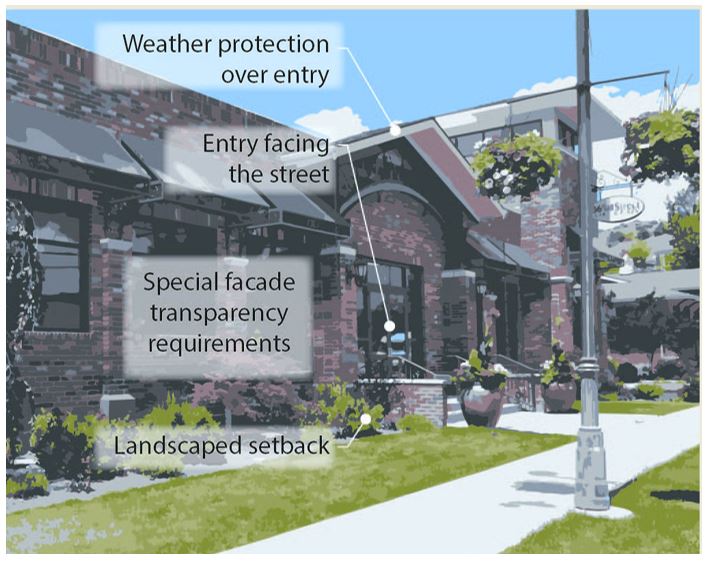
(2) Standards. All development as set forth in POMC 20.127.130 on sites containing a landscaped block frontage designation must comply with the following standards (on applicable block frontages):
|
Element |
Standards |
Examples and Notes |
|---|---|---|
|
Building placement |
10-foot minimum front setback, except where greater setbacks are specified in the district in Chapter 20.122 POMC or where future right-of-way need and/or acquisitions have been identified in city plans. ➲ |
See POMC 20.127.230 for special design provisions associated with ground level residential uses adjacent to a sidewalk. |
|
Building entrances |
Building entrances must be visible and directly accessible from the street. ➲ For uses that front on multiple mixed designated block frontages, an entry along both streets is encouraged, but not required. |
|
|
Facade transparency |
25 percent minimum for buildings design with ground level nonresidential uses. ➲ 20 percent minimum for residential uses. ➲ Windows must be provided on all habitable floors of the facade. |
Also see POMC 20.127.140 for additional clarification on transparency standards. Facade transparency example. |
|
Weather protection |
Provide weather protection at least three feet deep over primary business and residential entries. |
|
|
Parking location Also see Chapter 20.124 POMC for related parking requirements. |
Parking must be placed to the side, rear, below or above uses. For multi-building developments, surface and structured parking areas (ground floor) are limited to no more than 50 percent of the street frontage. Private or shared garage entries must occupy no more than 50 percent of facade width. Provide a 10-foot minimum buffer of landscaping between the street and off-street parking areas meeting the standards of Chapter 20.128 POMC. ➲ |
|
|
Landscaping Also see Chapter 20.128 POMC for related landscaping standards. |
The area between the street and building must be landscaped, private porch or patio space, and/or pedestrian-oriented space. For setbacks adjacent to buildings with windows, provide low level landscaping that maintains views between the building and the street. Also provide plant materials that screen any blank walls and add visual interest at both the pedestrian scale and motorist scale. For extended wall areas, provide for a diversity of plant materials and textures to maintain visual interest from a pedestrian scale. |
|
|
Sidewalk width |
Six-foot minimum sidewalks are required. Wider sidewalks may be required where designated in other code sections or in the public works standards. |
|
(3) Departure Criteria. Departures from the above standards that feature the ➲ symbol will be considered by the reviewing authority (the director or hearing examiner, as appropriate), provided the alternative proposal meets the purpose of the standards, plus the following criteria:
(a) Building Entrances. Block frontages with steep slopes and/or those facing busy arterial streets and very limited pedestrian traffic may warrant some flexibility to this standard (particularly in residential districts).
(b) Facade Transparency. The proposed alternative design treatment of facade area between ground level windows provides visual interest to the pedestrian and mitigates impacts of any blank wall areas. No less than 40 percent of the facade between 30 inches and 10 feet above the sidewalk may be approved with a departure.
(c) Parking Location. There must be an acceptable tradeoff in terms of the amount and quality of landscaped area that is integrated with the development and the applicable parking location departure. Plus, the alternative must include design features to successfully mitigate the visual impact of additional parking areas along designated landscaped streets. (Ord. 050-22 § 11; Ord. 056-19 § 24; Ord. 008-18 § 2 (Exh. 1)).
20.127.170 Varied block frontage standards.
(1) Description/Purpose. The varied block frontage designation serves areas that accommodate a mixture of ground floor uses and allows a diversity of development frontages for the purpose of contributing to the visual character of the street and enhancing the pedestrian environment.
Figure 20.127.170(1)
Varied Block Frontage Options and Standards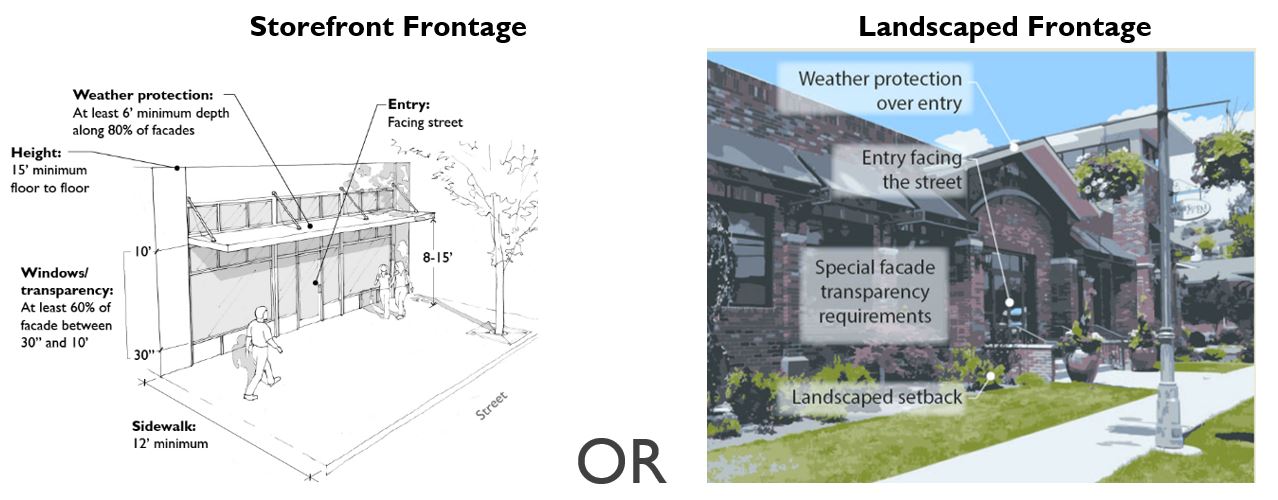
(2) Standards. All development as set forth in POMC 20.127.130 on sites containing a varied block frontage have the option to comply with either the storefront or landscaped block frontage provisions as set forth above, with the following modifications (on applicable block frontages):
|
Element |
Standards |
Examples and Notes |
|---|---|---|
|
Building placement |
Buildings may be placed up to the sidewalk edge provided they meet storefront standards set forth above. 10-foot minimum front setback for other buildings, except where greater setbacks are specified in the district per Chapter 20.122 POMC. ➲ Additional setbacks may be required where future right-of-way need and/or acquisitions have been identified in city plans. |
See POMC 20.127.230 for special design provisions associated with ground level residential uses adjacent to a sidewalk. |
|
Facade transparency |
Any storefront buildings on these block frontages must meet the storefront block frontage transparency standards above. ➲ 40 percent minimum for buildings designed with nonresidential uses on the ground floor within 10 feet of sidewalk. ➲ 25 percent minimum for buildings designed with nonresidential uses on the ground floor. ➲ 20 percent minimum for residential buildings. ➲ Windows must be provided on all habitable floors of the facade. |
Also see POMC 20.127.140 for additional clarification on transparency standards. Facade transparency example – nonresidential use. Facade transparency example – residential use. |
(3) Departure Criteria. Departures from the above standards that feature the ➲ symbol will be considered by the reviewing authority (the director or hearing examiner, as appropriate), provided the alternative proposal meets the purpose of the standards, plus the following criteria:
(a) Minimum Setback. For residential uses, provide design treatments that create an effective transition between the public and private realm. This could include a stoop design or other similar treatments that utilize a low fence, retaining wall, and/or hedge along the sidewalk.
Figure 20.127.170(3)
Stoop Examples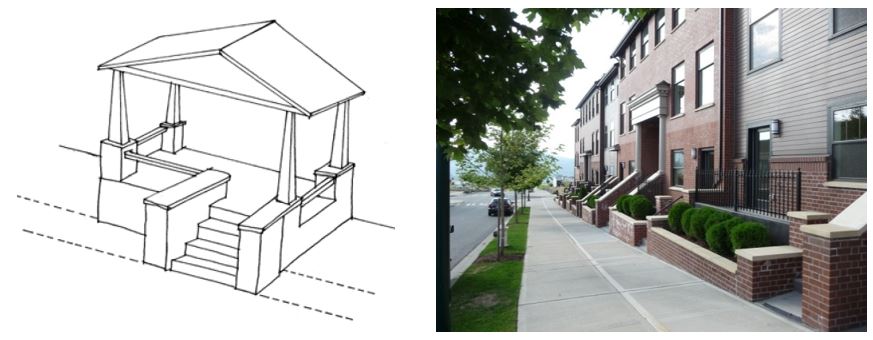
(Ord. 056-19 § 24; Ord. 008-18 § 2 (Exh. 1)).
20.127.180 Marine block frontage standards.
(1) Description/Purpose. The marine block frontage designation serves areas that accommodate a mixture of ground floor uses and allows a diversity of development frontages for the purpose of contributing to the visual character of the street and enhancing the pedestrian environment.
(2) Standards. All development as set forth in POMC 20.127.130 on sites containing a marine block frontage have the option to comply with either the storefront or landscaped block frontage provisions as set forth above, with the following modifications (on applicable block frontages). Additionally, all development within the 200-foot shoreline zone must comply with the requirements of the city’s shoreline master program, including but not limited to requirements for location (including setbacks from the shoreline), allowable uses within the applicable shoreline environment designation, view protection and public access.
|
Element |
Standards |
Examples and Notes |
|---|---|---|
|
Building placement |
Buildings may be placed up to the sidewalk edge provided they meet storefront standards set forth above. 10-foot minimum front setback for other buildings, except where greater setbacks are specified in the district per Chapter 20.122 POMC. ➲ Additional setbacks may be required where future right-of-way need and/or acquisitions have been identified in city plans. |
See POMC 20.127.230 for special design provisions associated with ground level residential uses adjacent to a sidewalk. |
|
Facade transparency |
Any storefront buildings on these block frontages must meet the storefront block frontage transparency standards above. ➲ 40 percent minimum for buildings designed with nonresidential uses on the ground floor within 10 feet of sidewalk. ➲ 25 percent minimum for buildings designed with nonresidential uses on the ground floor within 20 feet of the sidewalk. ➲ 20 percent minimum for residential buildings. ➲ Windows must be provided on all habitable floors of the facade. |
Also see POMC 20.127.140 for additional clarification on transparency standards. Facade transparency example – nonresidential use. Facade transparency example – residential use. |
|
Parking location |
Parking must be placed to the side, below, or above uses. No more than 50 percent of the street frontage may be occupied by parking and drive aisles. ➲ Parking in the front requires a departure (see subsection (3)(c) of this section). Parking to the rear may only be approved in conjunction with a variance and/or shoreline variance. The construction of any parking within a shoreline area must be consistent with the requirements of the city’s shoreline master program. No more than 50 percent of the street frontage may be occupied by parking and drive aisles. A 10-foot minimum buffer of landscaping must be provided between the street and off-street parking areas, which meets the landscaping requirements of Chapter 20.128 POMC. New parking structures must feature landscaped setbacks at least 10 feet in width. |
|
(3) Departure Criteria.
(a) Minimum Setback. For residential uses, provide design treatments that create an effective transition between the public and private realm. This could include a stoop design or other similar treatments that utilize a low fence, retaining wall, and/or hedge along the sidewalk.
(b) Facade Transparency. The proposed alternative design treatment of a facade area between ground level windows shall provide visual interest to the pedestrian and mitigate impacts of any blank wall areas. Up to a 40 percent reduction in the minimum amount of facade transparency may be approved via departure.
(c) Parking Location. Parking may be located in front of a building (between a building and an adjacent street) if other parking locations are demonstrated to be infeasible due to topography, property shape or size, or other contextual circumstances. When a departure is requested to allow parking in front of a building, the parking must provide an acceptable tradeoff in terms of the amount and quality of landscaped area that is integrated with the development and must include design features to successfully mitigate the visual impact of additional parking areas along the street. (Ord. 056-19 § 24; Ord. 008-18 § 2 (Exh. 1)).
20.127.190 Gateway block frontage standards.
(1) Description/Purpose. The gateway block frontage designation serves strategic areas fronted by highways or other high visibility arterials that feature heavy vehicular traffic. These standards serve the purpose of providing attractive landscaped frontages, limiting the extent of visible surface parking, and accommodating the needs of pedestrians.
Figure 20.127.190(1)
Gateway Block Frontage Vision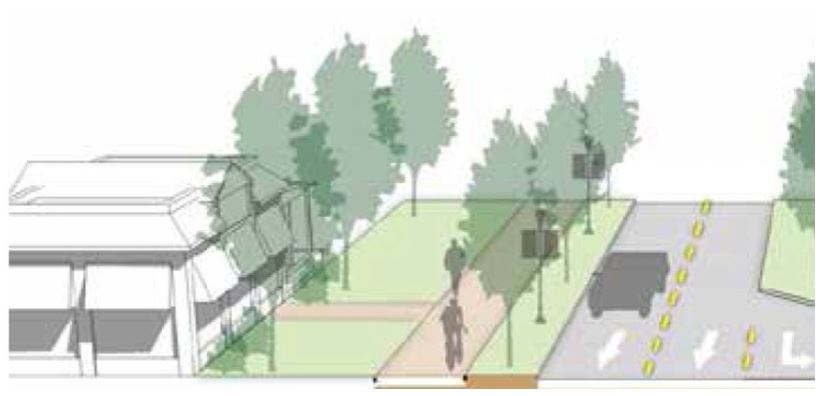
(2) Standards. All development as set forth in POMC 20.127.130 on sites containing the gateway block frontage designation must comply with the landscaped block frontage provisions as set forth above, with the following modifications:
|
Element |
Standards |
Examples and Notes |
|---|---|---|
|
Building placement |
The minimum setback for buildings is 25 feet. ➲ |
|
|
Building entrances |
At least one (publicly accessible for commercial buildings) building entrance must be visible and directly accessible from the street. ➲ |
|
|
Parking location |
Parking must be placed to the side, rear, below or above uses. ➲ For multi-building developments, surface parking and the ground floor of structured parking areas are limited to no more than 60 percent of the street frontage. ➲ A 25-foot buffer of landscaping between the street and off-street parking areas meeting the performance standards of Chapter 20.128 POMC. ➲ |
|
(3) Departure Criteria. See the departure criteria for landscaped frontages, POMC 20.127.160(3). (Ord. 008-18 § 2 (Exh. 1)).
20.127.200 Internal roadway storefront frontage standards.
(1) Description/Purpose. The internal roadway storefront block frontage designation is intended to apply to some existing commercial storefront areas that are located on internal roadways or parking lots. The purpose of this designation is to reinforce and enhance the storefront environment if and when changes occur over time.
Figure 20.127.200(1)
Internal Roadway Storefront Frontage Vision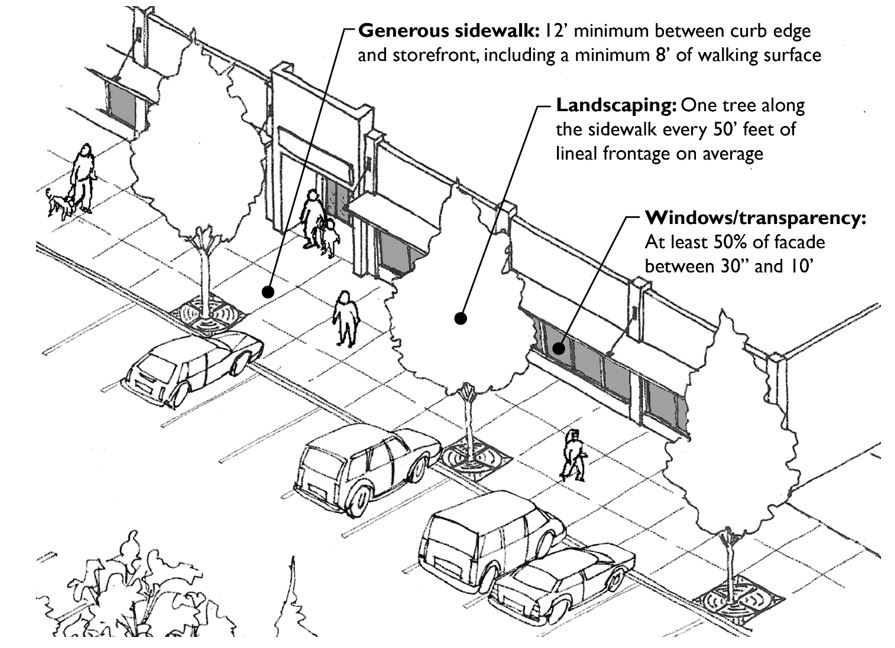
(2) Standards. Development as set forth in POMC 20.127.130 on sites containing the internal roadway storefront block frontage designation must comply with the storefront block frontage standards as set forth above, with only the following modifications:
|
Element |
Standards |
|---|---|
|
Facade transparency |
At least 50 percent of ground floor between 30 inches and 10 feet above the sidewalk. ➲ |
|
Landscaping |
Trees must be integrated along the sidewalk every 50 feet of lineal frontage on average. Trees may be in tree grates or in planting strips. |
|
Sidewalk width |
12 feet minimum between curb edge and storefront, including a minimum walking surface width of 8 feet and a clear/buffer zone with street trees. ➲ |
(3) Departure Criteria. See the departure criteria for storefront frontages, POMC 20.127.150(3). (Ord. 008-18 § 2 (Exh. 1)).
20.127.210 Other block frontage standards.
(1) Description/Purpose. All other block frontages in districts that are not designated in the design framework maps are provided greater flexibility with regards to the design of development frontages. These block frontages include a combination of side streets (where most uses front on other adjacent streets) and service oriented streets (often characterized by industrial or service types of uses). While there is greater flexibility in the amount of transparency of facade and the location of surface and structured parking, the purpose of these standards is to ensure that development frontages along these streets provide visual interest at all observable scales and meet the design objectives of the city.
(2) Standards. All development as set forth in POMC 20.127.130 with applicable block frontage designations must comply with standards below (on applicable block frontages):
|
Element |
Standards |
|---|---|
|
Building placement |
Where allowed in the applicable zoning district, buildings may be placed up to the sidewalk edge provided storefront block frontage standards above are met (except where otherwise noted herein). 10-foot minimum front setback for other buildings, except where greater setbacks are specified in the district per Chapter 20.122 POMC. ➲ See POMC 20.127.230 for special design provisions associated with ground level residential uses adjacent to a sidewalk. |
|
Building entrances |
Building entrances facing the street are encouraged. At a minimum, at least one building entry visible and directly accessible from the street is required. ➲ Where buildings are setback from the street, pedestrian connections are required from the sidewalk. |
|
Facade transparency |
For storefronts, at least 60 percent of ground floor between 30 inches and 10 feet above the sidewalk is required. ➲ Other buildings designed with nonresidential uses on the ground floor within 10 feet of sidewalk, at least 30 percent of the ground floor between four and eight feet above the sidewalk. ➲ Other buildings, at least 10 percent of the entire facade (all vertical surfaces generally facing the street). ➲ Window area that is glazed over or covered in any manner that obscures visibility into the storefront space shall not count as transparent window area. |
|
Weather protection |
At least three feet deep over primary business and residential entries. |
|
Parking location Also see Chapter 20.124 POMC for related parking requirements |
There are no parking lot location restrictions. A 10-foot buffer of landscaping between the street and off-street parking areas meeting the performance standards of Chapter 20.128 POMC is required. ➲ |
|
Landscaping Also see Chapter 20.128 POMC for related landscaping standards |
The area between the street and building must be landscaped and/or include private porch or patio space. For setbacks adjacent to buildings with windows, provide low level landscaping that maintains views between the building and the street. Also provide plant materials that screen any blank walls and add visual interest at both the pedestrian scale and motorist scale. For extended wall areas, provide for a diversity of plant materials and textures to maintain visual interest from a pedestrian scale. |
|
Sidewalk width |
Where storefront buildings are proposed, sidewalks must meet storefront block frontage standards above. Otherwise, six-foot wide minimum sidewalks are required. |
(3) Departure Criteria. Departures from the above standards that feature the ➲ symbol will be considered by the reviewing authority (the director or hearing examiner, as appropriate) provided the alternative proposal meets the purpose of the standards, plus the following criteria:
(a) Minimum Setback. Provide design treatments that create an effective transition between the public and private realm. This could include a stoop design to other similar treatments that utilize a low fence, retaining wall, and/or hedge alone the sidewalk.
(b) Facade Transparency. The design treatment of a facade and/or landscape element provides visual interest to the pedestrian and mitigates impacts of any blank wall area. (Ord. 008-18 § 2 (Exh. 1)).
20.127.220 Trail/park frontage standards.
Trails referenced in the community design framework maps in POMC 20.127.130 aligned adjacent to a street are subject to the applicable block frontage designation for the street. For trails referenced in the community design framework maps that are not adjacent to streets, developments fronting such trails must comply with the other block frontage standards set forth in POMC 20.127.210.
Figure 20.127.220
Trail/Park Frontage Examples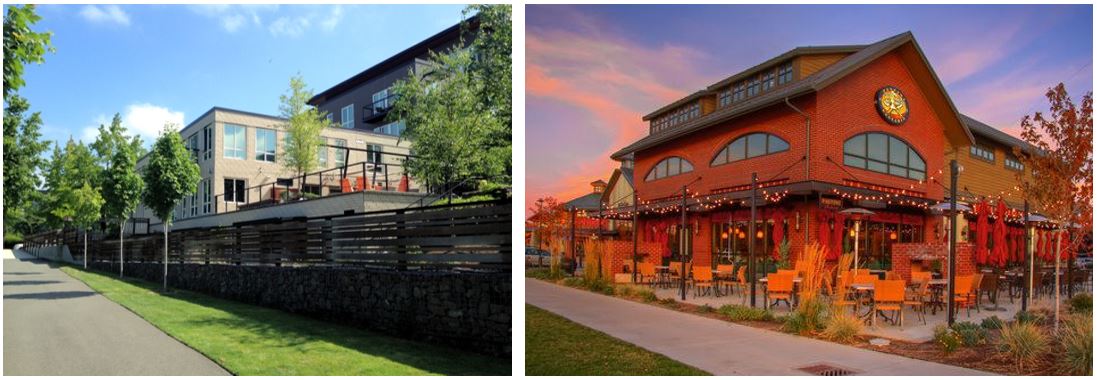
The development in the left image includes a courtyard that orients towards the trail. The low fence allows visibility between the uses, yet divides public and private space in an acceptable manner. The right image illustrates an active commercial use fronting on the trail.
(Ord. 008-18 § 2 (Exh. 1)).
20.127.230 Special residential frontage standards along sidewalks and internal walkways.
For residences with ground floor living spaces facing a sidewalk or pedestrian path in a residential or mixed use development, the building must feature at least one of the public/private space transition elements described below. The objective of this standard is to ensure privacy and security for residents, and an attractive and safe walkway that complements the qualities of the adjoining residences within a residential complex.
(1) Raised Deck or Porch Option. Provide at least a 60-square-foot porch or deck raised at least one foot above grade. The porch or deck must be at least six feet wide, measured perpendicular to the building face. (The deck may be recessed into the unit floor plan so that deck does not extend from the building face a full six feet.) A low fence, rail or hedge, two feet to four feet high, may be integrated between the sidewalk or internal walkway and deck or porch.
(2) Front Setback Options. Provide a minimum 10-foot setback between the sidewalk or internal walkway and the face of the residence. Design options for the front setback:
(a) Landscaped area, meeting the provisions of Chapter 20.128 POMC.
(b) Semi-private patio space screened by a low fence or hedge (see Chapter 20.128 POMC, Development Standards – Landscaping).
(3) Raised Ground Floor. If the residence’s ground floor is a minimum of three feet above the grade adjacent to the building, then the landscaped area in subsection (2)(b) of this section, may be reduced to four feet wide (except where greater setbacks are specified for the applicable zoning district in Chapter 20.122 POMC).
Departures: Other transition design measure that adequately protects the privacy and comfort of the residential unit and the attractiveness and usefulness of the walkway at least as effectively as subsections (1) through this subsection (3).
See Figure 20.127.230 below for examples of the above treatments.
Figure 20.127.230
Acceptable Public/Private Transitional Space Design between Sidewalk or Walkways and Ground Level Residential Units.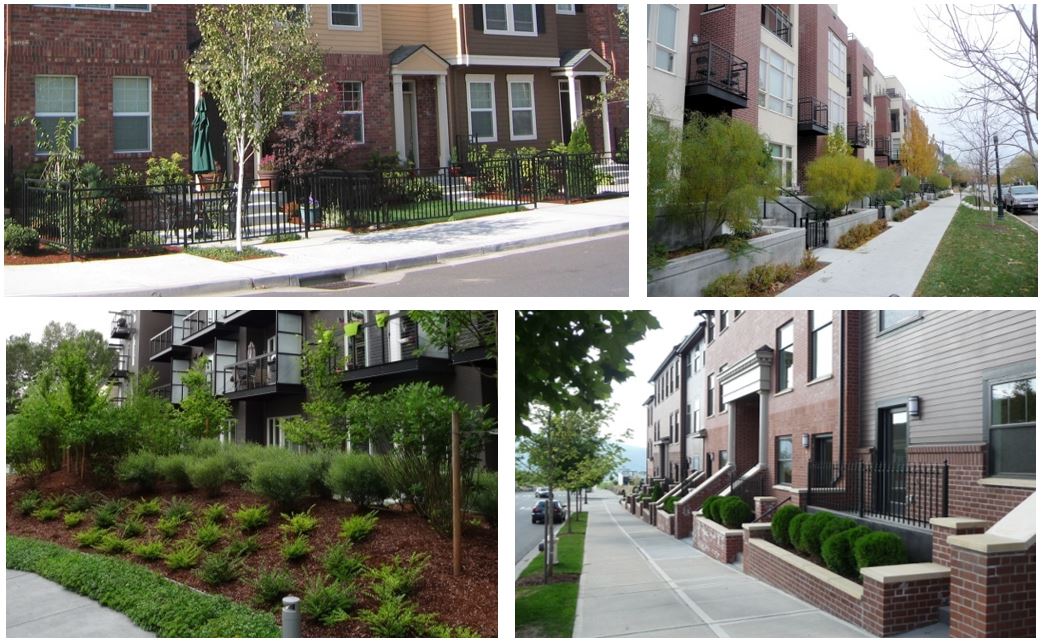
The upper left image uses a low fence and landscaped setback. The right images use landscaped terraces and elevated ground level units. The lower left image uses a landscaped berm between the walkway and semi-private open space.
(Ord. 008-18 § 2 (Exh. 1)).
20.127.240 Where a property fronts onto multiple streets/frontage designations.
Where a property fronts onto more than one street and each street has a different frontage designation, each building frontage must comply with the standards for the block frontage upon which it fronts, with the following clarifications:
(1) Where a conflict exists between frontage standards, the review authority will apply the standards of a block frontage pursuant to the following order of preference:
(a) Storefront.
(b) Varied.
(c) Marine.
(d) Landscaped.
(e) Gateway.
(f) Other.
Subsections (2) through (5) of this section clarify how the order of preference works for particular frontage elements.
(2) Building Location. For corner sites with landscaped block frontage on one street and storefront or varied on another, a storefront frontage may wrap around the corner (on the landscaped block frontage side) for up to a half block width or no more than 120 feet (whichever is more).
(3) Entrances. For corner sites, entrances on both streets are encouraged, but only one entrance is required. For corner sites with frontage on a storefront block frontage on one side, an entrance must be placed on the storefront block frontage side. For corner sites with a mix of designations that do not include a storefront block frontage, the entry must be placed in the order of preference identified above.
Departures may be considered, provided the location and design of the entry and block frontage treatments are compatible with the character of the area and enhance the character of the street.
(4) Transparency. For corner sites at least one block frontage must meet the applicable transparency standards (based on the order of preference above). For the second block frontage, the review authority may approve a reduction in the minimum amount of transparency by 50 percent. For street corners with the same designations on both frontages, buildings must employ the full transparency on the dominant frontage (based on the frontage width or established neighborhood pattern).
(5) Parking. Surface parking (including ground floor parking in a structure) adjacent to a street corner is not allowed, except:
(a) Corner lots with nondesignated frontages (other) on both streets.
(b) Other combination of block frontages, except those with a storefront designation, via a departure and subject to the applicable departure criteria.
Figure 20.127.240
Clarifying Block Frontage Standards on Street Corners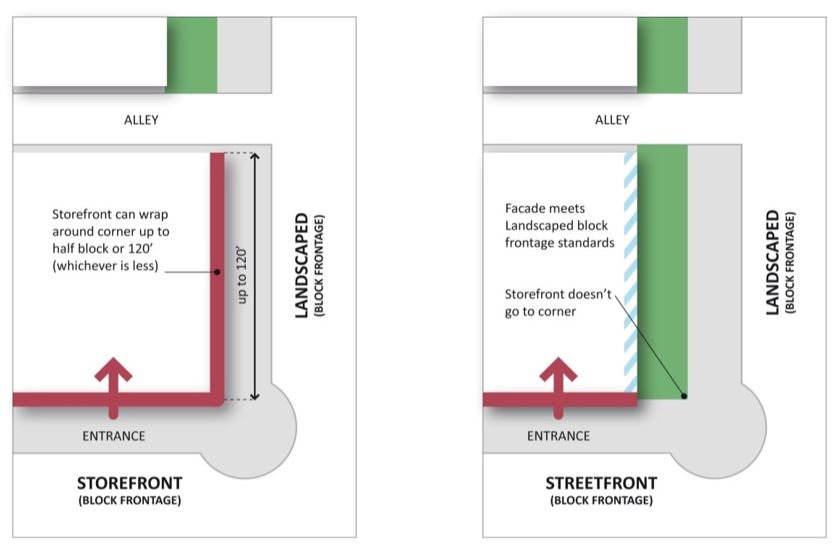
(Ord. 008-18 § 2 (Exh. 1)).
20.127.250 High visibility street corners.
(1) Description/Purpose. The high visibility street corner requirements apply to those sites designated as such on the community design framework maps in POMC 20.127.130. The purpose is to accentuate street corners with high visibility to the public.
(2) Designation Criteria. High visibility street corners may be designated in:
(a) Special high visibility intersections in business districts.
(b) Intersections with a high level of pedestrian activity.
(c) Special high visibility gateway intersections leading into the city or a particular business district.
(d) Existing or planned intersections that are intended to become the focal point of a particular business district or neighborhood center.
(3) Standards. Sites located on high visibility street corners must meet the following requirements:
(a) Buildings must be located within 20 feet of the street corner.
(b) At least one of the following special features must be included (Figure 20.127.250 below illustrates acceptable examples):
(i) Corner plaza.
(ii) Cropped building corner with a special entry feature.
(iii) Decorative use of building materials at the corner.
(iv) Distinctive facade articulation.
(v) Sculptural architectural element.
(vi) Other decorative elements that meet the purpose of the standards.
Figure 20.127.250
Acceptable High Visibility Street Corner/Gateway Site Examples
Building 1 includes a corner tower. Building 2 features cropped building corners with decorative elements. Building 3 uses a decorative canopy. Building 4 uses a change in building materials and facade articulation at the corner. Building 5 incorporates a plaza at the corner.
Image 6 shows a decorative landscaped area with a trellis and neighborhood gateway sign.
(Ord. 008-18 § 2 (Exh. 1)).
20.127.260 Community design framework master plan.
Recently annexed or rezoned commercial or mixed use properties along with large undeveloped sites necessitate a different approach to applying block frontage standards. The provisions below identify the purpose, applicable sites, block frontage designation options, and special standards for developing community design framework master plans. Such master plans are also an option for property owners to change designations on existing community design framework maps (POMC 20.127.130).
(1) Purpose.
(a) To provide a thoughtful and fair process to plan for the development of large and new commercial and mixed use sites consistent with Port Orchard’s comprehensive plan.
(b) To promote the arrangement of streets, buildings, open space, parking and service areas that creates a strong sense of community and enhances the character of Port Orchard.
(c) To avoid uncoordinated patterns of development that waste valuable land, compromise vehicular and pedestrian access, and degrade the character of Port Orchard.
(2) Applicable Sites.
(a) Recently annexed sites zoned as one of the commercial or mixed use zoning districts.
(b) Sites recently rezoned to one of the commercial or mixed use zoning districts that are not addressed in the community design framework maps in POMC 20.127.130.
(3) Block Frontage Designations Options.
(a) Prior to site development of applicable sites, a community design framework master plan must be developed, approved and adopted into the Port Orchard comprehensive plan per the procedures set forth in Chapter 20.04 POMC, Comprehensive Plan Amendments. The master plans must include:
(i) New streets and internal roadways along with block frontage designations (types included in this section).
(ii) Any designated high visibility street corners.
(iii) Any planned open spaces, trails, and shared use paths.
(iv) Any special phasing conditions.
(v) Other special design conditions unique to the site and plan that must be implemented with future site plan development.
(b) Community design framework master plans may utilize any existing block frontage designations that border the site, or include an alternative block frontage designation type or types, subject to master plan approval.
(c) Alternatively, site plan development may occur on applicable sites without an approved and recorded community design framework master plan provided all block frontages comply with the standards for varied block frontages as set forth in subsection (4) of this section.
(4) Design Standards. Community design framework master plans must meet the purpose as set forth above plus the following parameters for specific sites:
|
The provisions below are intended to guide the design of individual community design framework master plans. They are referred to as standards, since all proposed plans must successfully demonstrate how they comply with the provisions herein. |
|
|
All Sites |
• Configure site to create a pedestrian-oriented focal point. Such a focal point could be a main street (storefront), a central square surrounded by storefronts or other similar features. • Larger sites have greater expectations in the amount of storefront designated frontages. • Goals, policies and concepts from adopted plans must be used to help determine compliance with these standards. |
Figure 20.127.260(4)
Development Examples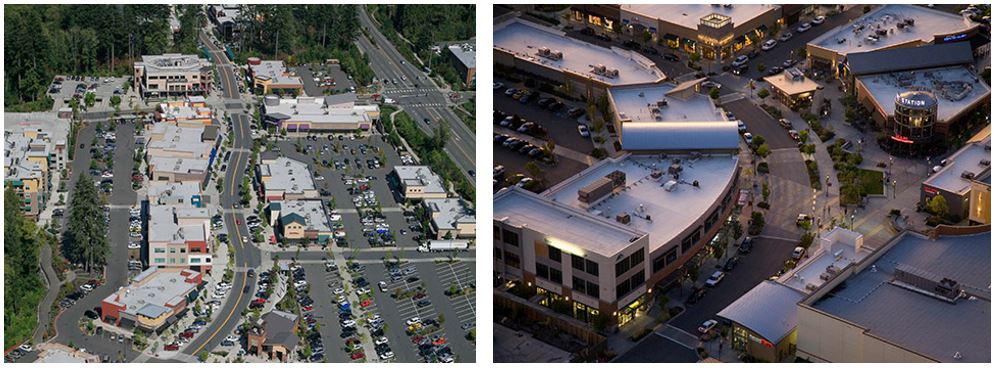
Examples of commercial centers configured to create a pedestrian-oriented focal point. Parking areas are carefully located to provide convenience while minimizing impacts to the visual and pedestrian environment.
(5) Review Process and Application Requirements.
(a) Community design framework master plans must be processed as a Type II decision set forth in POMC 20.22.040.
(b) Community design framework master plans are subject to application requirements set forth in Chapter 20.24 POMC. Supplemental application submittal requirements include:
(i) A conceptual site development plan that identifies the following elements (if applicable):
(A) Proposed new public and private streets (including any public rights-of-way).
(B) Proposed block frontage designations.
(C) Proposed land use(s) concept (to the extent anticipated or desired).
(D) Proposed nonmotorized circulation elements.
(E) Proposed pedestrian-oriented focal point and/or other open spaces or recreational features.
(F) Critical areas and buffers.
(G) Utility areas.
(H) Proposed or potential development phases.
(ii) Other information as necessary to support compliance with the design standards set forth in subsection (4) of this section. (Ord. 008-18 § 2 (Exh. 1)).
Article III. Site Planning Standards
20.127.300 Purpose.
(1) To preserve and protect the public health, safety, and welfare of the citizens of Port Orchard.
(2) To promote the thoughtful layout of buildings, parking areas, circulation, service areas, landscaping, and amenity elements that enhances Port Orchard’s visual character, promotes compatibility between developments and uses, and enhances the function of developments.
Also see the individual “purpose” statements for each section in this article. (Ord. 008-18 § 2 (Exh. 1)).
20.127.310 Applicability and compliance.
(1) See POMC 20.127.020(1) for clarification on the types of development to which these standards apply; provided, that applications for interior alterations are exempt from site plan review, if the interior alteration does not result in (a) additional sleeping quarters or bedrooms; (b) nonconformity with Federal Emergency Management Agency substantial improvement thresholds; or (c) an increase in the total square footage or valuation of the structure thereby requiring upgraded fire access or fire suppression systems. For purposes of this section, “interior alterations” include construction activities that do not modify the existing site layout or its current use and involve no exterior work adding to the building footprint.
(2) See POMC 20.127.020(2) for the relationship between the provisions in this article and other documents and codes.
(3) See POMC 20.127.020(3) for the application of building additions and remodels and site improvements. (Ord. 019-24 § 18; Ord. 008-18 § 2 (Exh. 1)).
20.127.320 Relationship to adjacent properties.
(1) Purpose.
(a) To promote the functional and visual compatibility between developments.
(b) To protect the privacy of residents on adjacent properties.
(2) Balconies Adjacent to Side Property Lines Abutting Residentially Zoned Properties. Balconies or rooftop decks within 15 horizontal feet of a side and rear property line abutting a residentially zoned property must feature a railing system that is at least 50 percent opaque. Specifically, 50 percent of the area below the railing must be a sight-obscuring structure.
Departures will be allowed where it is determined that the proposed design will not create a compatibility problem in the near- and long-term based on the unique site context.
Figure 20.127.320(2)
Privacy Standards for Balconies within 15 Feet of Side Property Lines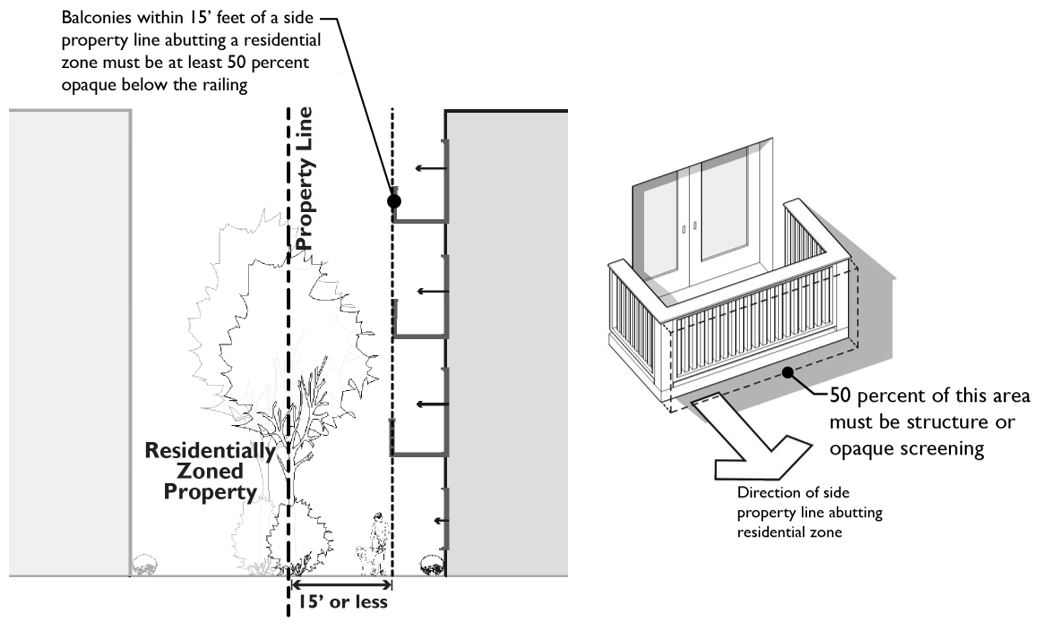
(3) Light and Air Access and Privacy along the Side and Rear Property Lines. Buildings or portions thereof containing multi-household dwelling units whose only solar access (windows) is from the applicable side of the building (facing towards the side property line) must be set back from the applicable side or rear property lines at least 15 feet. See Figures 20.127.320(2) and (3).
Departures will be allowed where it is determined that the proposed design will not create a compatibility problem in the near- and long-term based on the unique site context.
Figure 20.127.320(3)
Solar Access and Privacy Standards for Multi-Household Residential Buildings along Side/Rear Property Lines
Where side setbacks are required.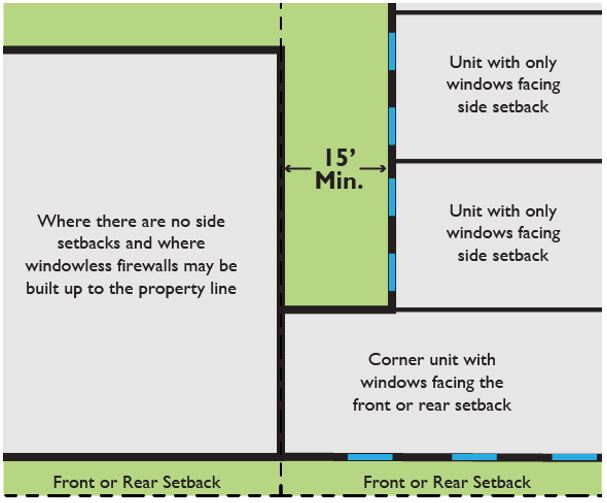
Where there are no side setbacks and where windowless firewalls may be built up to the property line.
(Ord. 008-18 § 2 (Exh. 1)).
20.127.330 Nonmotorized circulation and design.
(1) Purpose.
(a) To improve the pedestrian and bicycling environment by making it easier, safer, and more comfortable to walk or ride among residences, to businesses, to the street sidewalk, to transit stops, through parking lots, to adjacent properties, and to connections throughout the city.
(b) To enhance access to on- and off-site areas and pedestrian/bicycle paths.
(2) Access to Sidewalk. All buildings must feature pedestrian connections to a sidewalk per applicable block frontage standards in Article II of this chapter. See subsection (4) of this section for access design requirements.
Figure 20.127.330(2)
Examples of Direct Pedestrian Access to Buildings from the Street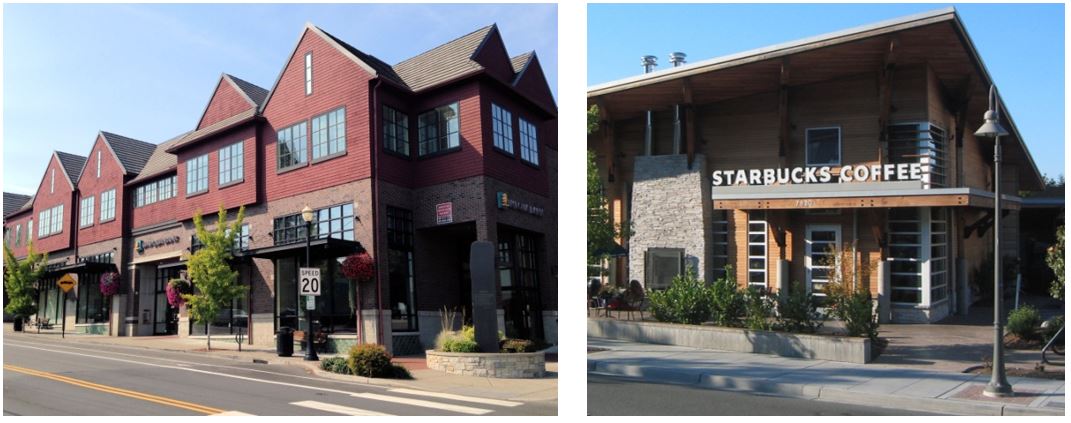
(3) Internal Circulation.
(a) For sites with multiple buildings, pedestrian paths or walkways connecting businesses and residential entries on the same development site must be provided. Routes that minimize walking distances must be utilized to the extent practical.
Departures will be allowed where steep slopes prevent a direct connection or where an indirect route would enhance the design and/or use of a common usable open space. See subsection (4) of this section for walkway design standards.
Figure 20.127.330(3)(a)
Internal and External Pedestrian Connections Are Important
(b) Sites with Residential Units. Provide direct pedestrian access between all ground related unit entries and a public street or to a clearly marked walkway network or open space that has direct access to a public street. Residential developments must provide a pedestrian circulation network that connects all main entrances on the site to other areas of the site, such as:
(i) Parking areas.
(ii) Recreational areas.
(iii) Common outdoor areas.
(iv) Any pedestrian amenities.
For townhouses or other residential units fronting the street, the sidewalk may be used to meet this standard.
Figure 20.127.330(3)(b)(i)
Direct Walkways between the Street and Dwelling Units Are Required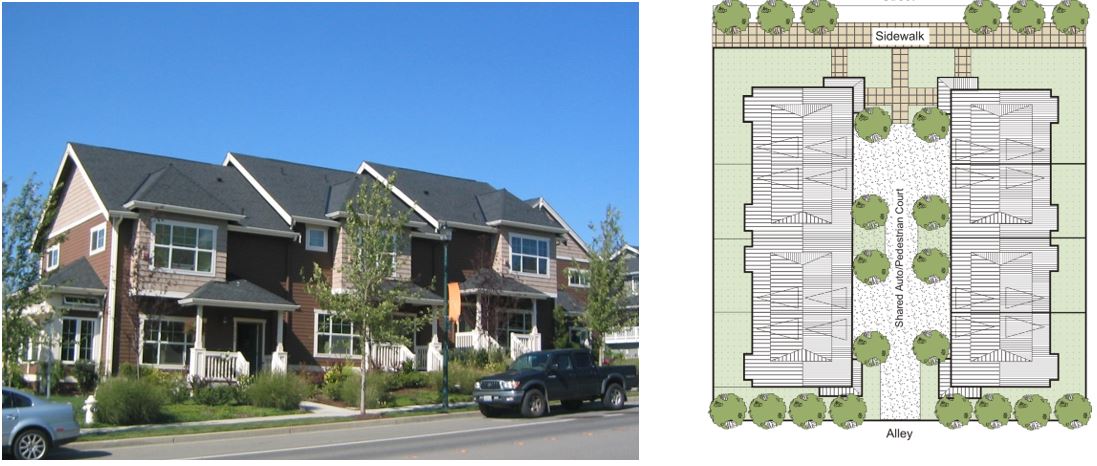
The entries of the example on the left connect directly to a public sidewalk while the entries in the right example connect to a common path that extends to the sidewalk.
Figure 20.127.330(3)(b)(ii)
Examples of Attractive Pedestrian Connection through a Residential Development
(c) Crosswalks are required when a walkway crosses an on-site paved area accessible to vehicles. Crosswalks must contain contrasting material (such as concrete) and/or patterns (such as stamped asphalt), excluding painted surfaces.
(d) Pedestrian Walkways through Parking Lots. Developments with 50 parking spaces or more must provide specially marked or paved walkways through parking areas. At least one walkway must be provided every four rows of parking or at a maximum spacing of 200 feet. The walkways must provide a safe connection to the building entrance and meet the walkway design standards set forth in subsection (4) of this section. See examples below.
Figure 20.127.330(3)(d)
Parking Area Walkway Standards and Examples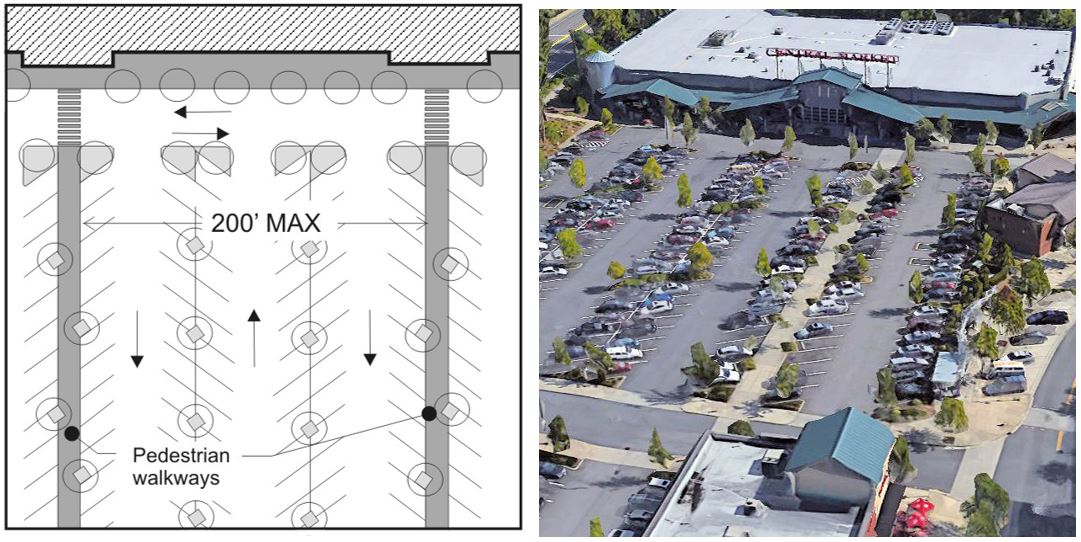
Note the location of the parking lot walkway in the upper right example (connecting shops in one building to the main entry of a grocery store).
Note in both examples that the concrete walkway extends into the vehicular area to provide a highly visible and safe crosswalk.
(e) Connections to Adjacent Properties (Including Parks and Trails). Except for when adjacent properties have less than five dwelling units, provide pedestrian walkways that connect to adjacent properties. Public sidewalks in the right-of-way shall not count towards this requirement.
Departures will be allowed where it is determined that internal connections are not necessary or practical due to shallow lot depths, steep slopes, or other contextual challenges.
(f) Barriers that limit future pedestrian access are prohibited. Gates that limit access to employees are permitted. See subsection (4) of this section for walkway design standards.
(4) Walkway Design.
(a) All internal pedestrian walkways must have a minimum five-foot-wide unobstructed walking surface, except where wider walkways are prescribed in this article or where the applicable uses and context dictate wider walkways.
(b) Where parking is adjacent to perpendicular or angled parking and does not utilize wheel stops as described in POMC 20.124.100, an extra two feet of walkway width must be provided to mitigate for parked vehicles overhanging the walkway.
(c) Pedestrian walks must be separated from structures at least three feet for landscaping except where the adjacent building facade meets the storefront block frontage standards per POMC 20.127.120(2).
Departures will be considered where other landscaping and/or facade design treatments to provide attractive walkways are proposed. Examples include sculptural, mosaic, bas-relief artwork, or other decorative treatments that meet the purpose. Figure 20.127.330(4)(c) below provides one example.
Figure 20.127.330(4)(c)
Standards for Internal Walkways Adjacent to Buildings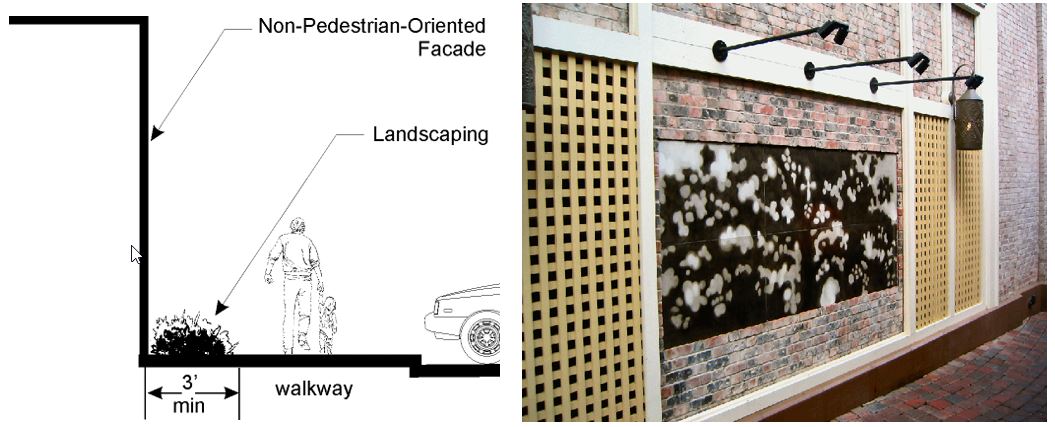
Internal walkways adjacent to building walls that do not meet storefront facade standards must provide at least three feet of landscaping to enhance the character of the walkway. The reviewing authority will consider alternative treatments, such as decorative walls (right example).
(d) Walkway design where multi-tenant commercial or mixed use buildings 100 feet or more in length abut parking lots. Such walkways must feature a 12-foot-wide sidewalk with:
(i) Eight feet minimum unobstructed width.
(ii) Trees, as approved by the director or hearing examiner, placed at an average of 50 feet on-center and placed in grates or in planting strips as set forth in subsection (4)(d)(iii) of this section.
Departure: Breaks in the tree coverage will be allowed near major building entries to enhance visibility.
(iii) Planting strips may be used between any vehicle access or parking area and the walkway; provided, that the trees required above are included and the walkway meets the applicable width standards herein and the combined walkway and planting strip is at least 12 feet wide.
(iv) See also POMC 20.127.340(4), internal roadway design.
Figure 20.127.330(4)(d)
Example of a Successful Pedestrian Sidewalk between Parking Lot and Storefront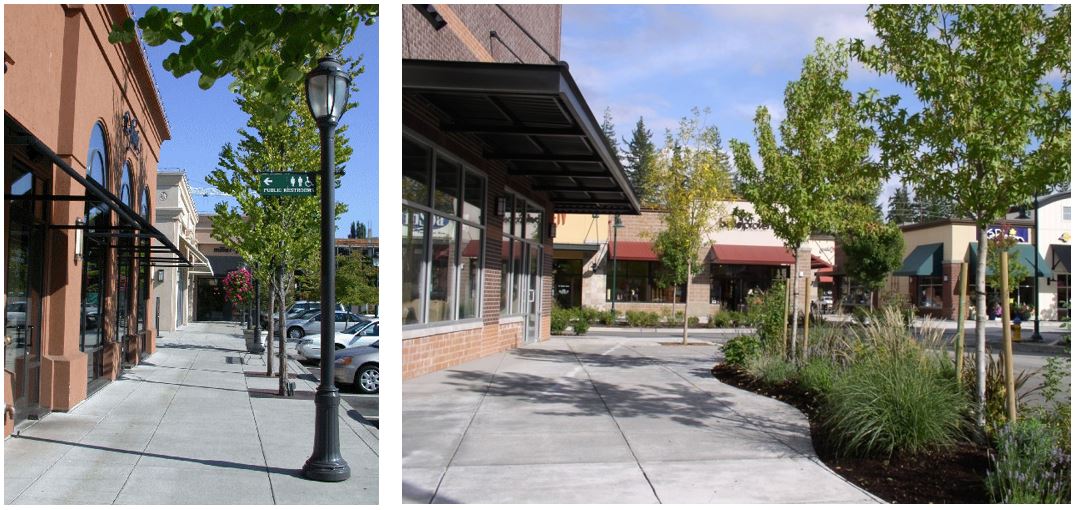
(Ord. 050-22 § 12; Ord. 008-18 § 2 (Exh. 1)).
20.127.340 Vehicular circulation and parking.
The standards herein supplement the provisions of public works standards and Chapter 20.124 POMC. Where there is a conflict, the provisions herein apply, except that the public works director may override this requirement and apply the public works standard for a driveway if the public works director finds that a failure to apply the public works standards will result in a threat to public safety.
(1) Purpose.
(a) To create a safe, convenient, and efficient network for vehicle circulation and parking.
(b) To enhance the visual character of interior access roads.
(c) To minimize conflicts with pedestrian circulation and activity.
(2) Driveway Provisions.
(a) Driveways must comply with the public works standards. Where there is a conflict between the driveway provisions in this chapter and those in the public works standards, the driveway provisions in this chapter apply, except that the public works director may override this requirement and apply the public works standard for a driveway if the public works director finds that a failure to apply the public works standards will result in a threat to public safety.
(b) Drive aisles must meet the standards set forth in POMC 20.124.100, Off-street parking design standards.
(c) Minimize parking lot entrances, drive aisles, and other vehicle access routes onto private property from a public right-of-way through the following means:
(i) Driveway lanes crossing a public sidewalk must be no wider than the minimum required per entry or exit lane. The city may impose additional restrictions to parking lot and vehicle access points to reduce impacts to public safety, pedestrian movement, on-street vehicle circulation, and visual qualities.
(ii) Minimize the number of driveway entrances and comply with the public works standards for driveway entrances.
(iii) The reviewing authority may require joint drive aisles serving adjacent developments when joint access is physically and legally available.
(iv) Minimize conflicts between entries and vehicle parking and maneuvering areas.
(v) At street corner sites, drive aisles must be located on the lowest classified roadway and as close as practical to the property line most distant from the intersection, unless the reviewing authority finds there is a compelling reason to the contrary.
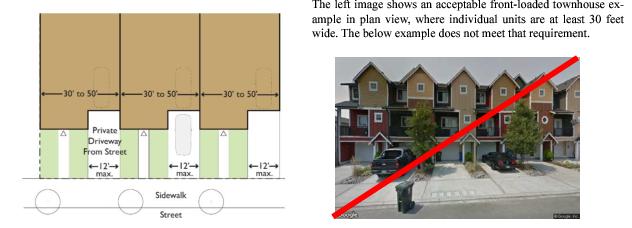
(d) Port Orchard Boulevard Access. Access from Port Orchard Boulevard except for areas with a designated block frontage as shown in the community design framework maps in POMC 20.127.130 shall be prohibited.
(3) Intersite Connectivity. The provision of through vehicle access connections between commercially or nonresidentially zoned properties is required except where the reviewing authority determines it is infeasible or undesirable (e.g., where it is determined that such a vehicle connection would impact safe pedestrian movement). See Article II of this chapter for specific block frontage standards. Vehicle access may be in the form of a dedicated or private alley, connected or shared parking lots, shared drive aisles, or similar features.
(4) Internal Roadway Design.
(a) To increase the function and appearance of internal roadways on large sites (greater than two acres), street trees and sidewalks must be provided on all internal access roadways, excepting access roads designed solely for the purpose of service (e.g., waste pick-up) and loading.
(b) In some instances where traffic speed and volume are low, the reviewing authority may approve a street where vehicle, bicycle and pedestrian movement are mixed such as in a “woonerf” or “shared street.” Woonerf streets must feature traffic calming and safety measures as well as landscape and amenity features as determined by the reviewing authority.
Figure 20.127.340(4)
Good Internal Roadway Examples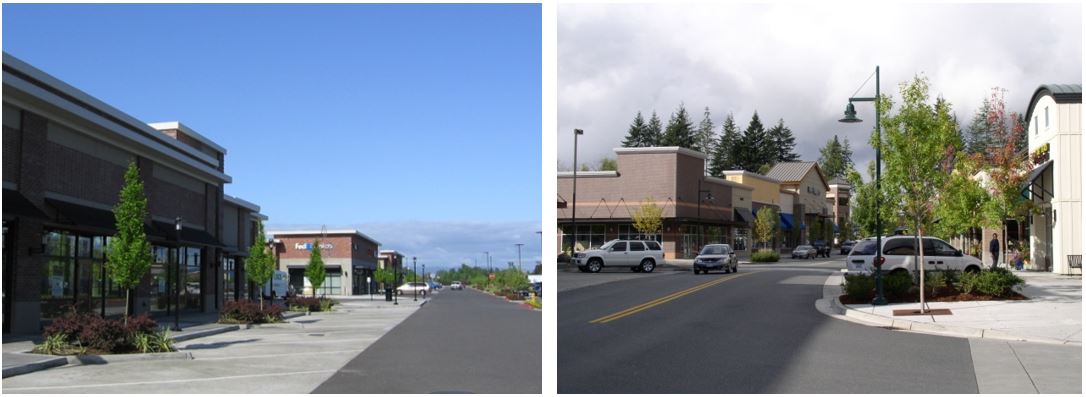
The examples above include angled parking and planter strips with street trees. Pedestrian-scaled lighting also contributes to the character in the upper right image.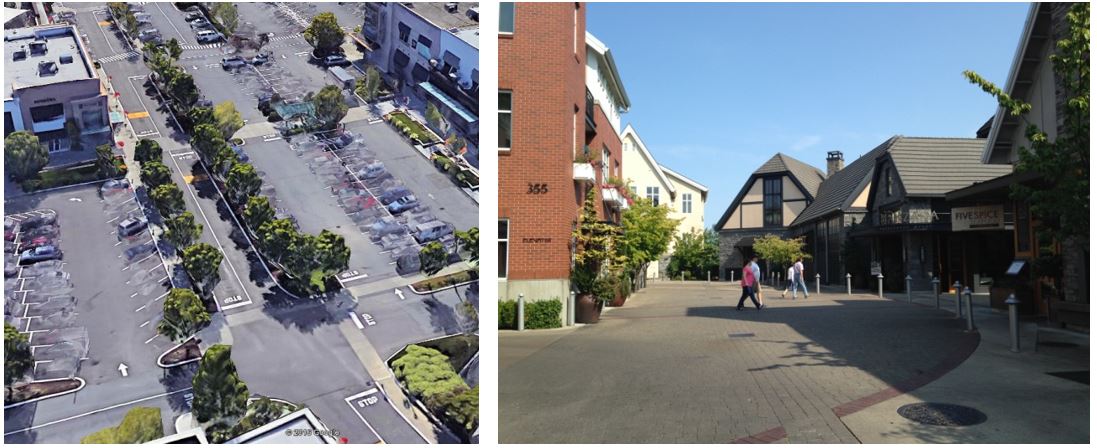
The above left image illustrates a thoroughfare lane with a row of street trees. A sidewalk is included on one side of the street to provide a strategic connection between businesses. The right image illustrates the curbless “woonerf” design where travel speeds are low and lanes are shared between pedestrians and vehicles.
(c) Drive-Through Facilities. Where allowed, drive-through facilities (e.g., drive-up windows) must comply with the following:
(i) Drive-through lanes, including waiting and holding lanes, must be buffered from the street and internal walkways by one or both of the following:
(A) A planting strip at least five feet wide with continuous plantings of evergreen shrubs and/or trees that will, at maturity, provide a continuous evergreen screen at least four feet tall.
(B) A wall at least three feet high constructed of brick, stone or siding materials that matches the principal walls of the building.
Departure: Alternative screening schemes may be approved provided they include both the wall and a substantial vegetative screen. The landscaping must comply with Chapter 20.128 POMC.
(ii) Drive-through lanes must not restrict pedestrian access between a public sidewalk and on-site buildings. Walkways must not be located within required stacking space as set forth in the public works standards.
(iii) This section contains standards for drive-through lanes and facilities. Signs associated with drive-through lanes are regulated under POMC 20.132.150(7). (Ord. 033-20 § 12; Ord. 056-19 § 23; Ord. 011-19 § 6 (Exh. 3); Ord. 008-18 § 2 (Exh. 1)).
20.127.350 On-site open space.
(1) Purpose.
(a) To create useable space that is suitable for leisure or recreational activities for residents.
(b) To create open space that contributes to the residential setting.
(c) To provide plazas that attract shoppers to commercial areas.
(d) To provide plazas and other pedestrian oriented spaces in commercial areas that enhance the employees’ and public’s opportunity for active and passive activities, such as dining, resting, people watching, and recreational activities.
(e) To enhance the development character and attractiveness of commercial development.
(2) Usable Residential Open Space.
(a) All multi-household development, including multi-household portions of mixed use development, must provide minimum usable open space equal to 100 square feet per dwelling unit for studio and one-bedroom dwellings and 150 square feet per dwelling unit for dwellings with two or more bedrooms.
Developments adjacent to or across the street from a public park can qualify for a 50 percent reduction in the required open space via a departure, where it is determined that both the park and access to the park help to meet the usable open space purpose.
The required open space may be provided in a combination of ways:
(i) Shared Open Space. One hundred percent of the required open space may be in the form of shared open space available to all residents and meeting the requirements of subsection (2)(b) of this section. Shared open space may be in the form of courtyards, front porches, patios, play areas gardens or similar spaces.
(ii) Ground Level Private Outdoor Space. One hundred percent of the required open space may be provided by ground level outdoor space that is adjacent and directly accessible to the subject unit. Such open spaces must be enclosed by a fence and/or hedge at least 32 inches in height to qualify. Ground level private open space in excess of minimum requirements must not be used in the calculations for determining the minimum useable open space requirements for other units in the development.
(iii) Balconies. Up to 50 percent of the required open space may be provided by private balconies provided they are at least 36 square feet with no dimension less than six feet. Individual balconies in excess of minimum requirements must not be used in the calculations for determining the minimum useable open space requirements for other units in the development.
(iv) Common Indoor Recreation Areas. Up to 50 percent of the required open space may be provided by common indoor recreation areas meeting the requirements of subsection (2)(c) of this section.
(v) Shared Roof Decks. For mixed use buildings, up to 100 percent of the required open space may be provided by shared roof decks located on the top of buildings which are available to all residents and meet the requirements of subsection (2)(d) of this section. Roof decks in mixed use buildings shall not be accessible to commercial tenants, employees, or customers.
(b) Shared Open Space. Shared open space can include landscaped courtyards or decks, entrance plazas, gardens with walkways, children’s play areas, pools, and water features provided they are accessible to all residents of the development. Accessible areas used for storm water retention or other multipurpose recreational and/or green spaces that meet the design criteria herein may qualify as shared open space.
Special requirements for common usable open spaces include the following:
(i) Shared open space must be located in centralized areas that are visible from units within the development.
(ii) Required setback areas must not count as shared open space unless the design of the space meets the standards herein.
(iii) Shared open space must feature no dimension less than 15 feet in order to provide functional leisure or recreational activity (unless otherwise noted herein).
(iv) Shared open space must feature paths or walkable lawns, landscaping, seating, lighting, and play structures, sports courts, or other pedestrian amenities to make the area more functional and enjoyable for a range of users.
(v) Shared open space must be separated from ground level windows, streets, service areas and parking lots with landscaping, fencing, and/or other acceptable treatments that enhance safety and privacy for both the shared open space and dwelling units.
(vi) When possible, the space should be oriented to receive sunlight, face east, west or preferably south.
(vii) Stairways and service elements located within or on the edge of shared open space must not be included in the open space calculations.
(viii) Shared porches may qualify as shared open space provided they are at least eight feet in depth and 96 square feet in total area.
(ix) The space must be accessible to all residents of the development.
(x) Natural, artificial, and stormwater ponds may be included in the shared open space. A maximum of 50 percent of the pond surface area, as measured when the pond is at its maximum designed depth, may be counted towards the minimum requirements of subsection (2)(a) of this section. Ponds must be integrated with trails and other features listed above to qualify as shared open space.
Figure 20.127.350(2)(b)(i)
Shared Open Space Examples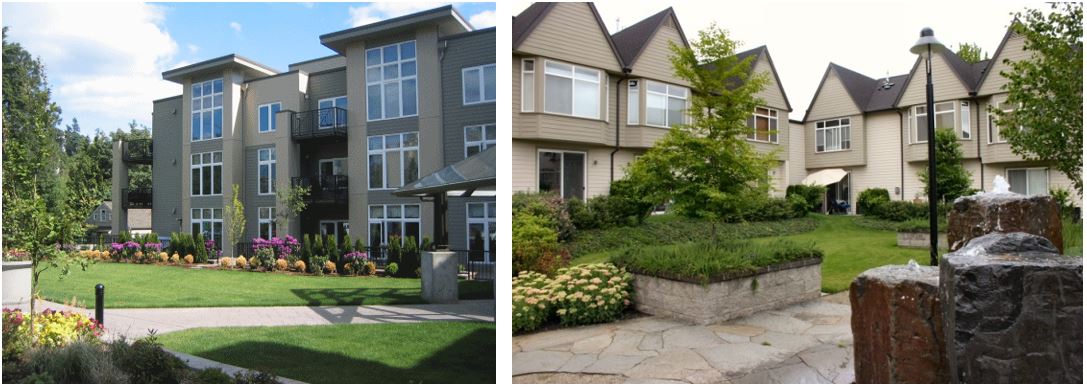
The upper examples include a combination of open lawn area for informal recreation plus walkways and decorative landscape areas to enhance the setting for residents.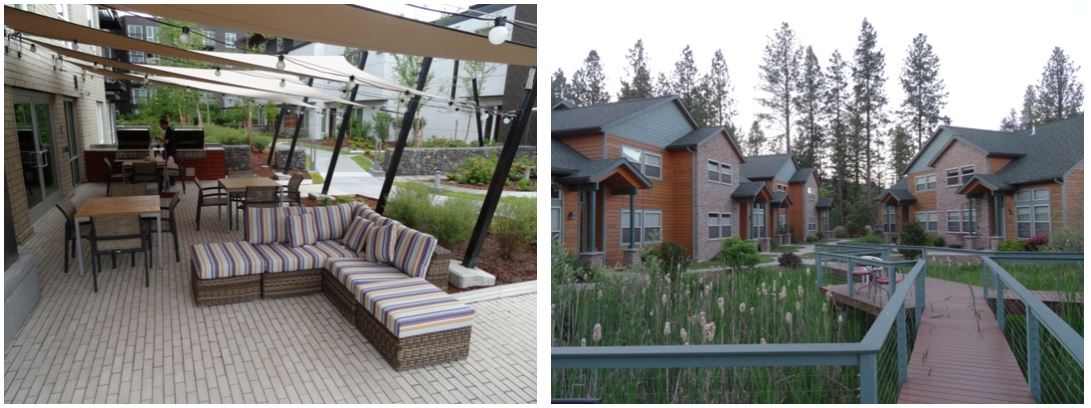
The left image above includes a covered gathering space with outdoor grills adjacent to a landscaped commons with a central walkway. The right image includes a pond/wetland type area with boardwalk and seating areas.
Figure 20.127.350(2)(b)(ii)
Acceptable and Unacceptable Examples of Ponds as Open Space
The above images show an acceptable example of using a pond as shared open space. Lawns, gentle slopes, and a perimeter walking path are integrated into this amenity.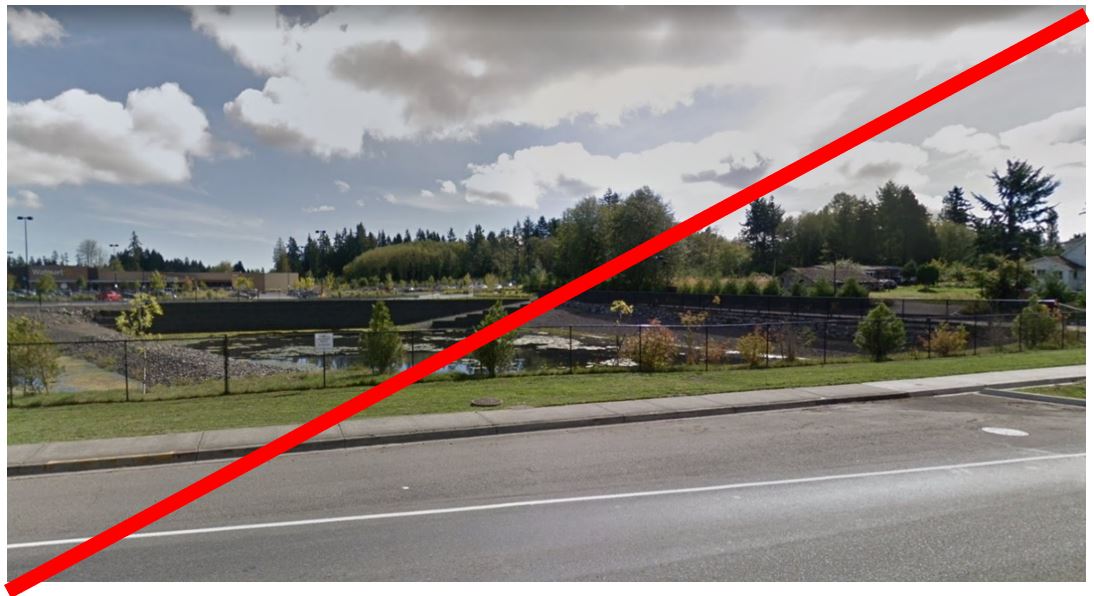
The above image shows a stormwater pond that would not qualify as shared open space. The pond is fenced, inaccessible to users of the development, and it is lined by steep rocky banks.
(c) Indoor Recreational Areas. Such spaces must meet the following conditions:
(i) The space must be located in a visible area, such as near an entrance, lobby, or high traffic corridors.
(ii) Space must be designed specifically to serve interior recreational functions and not merely be leftover unrentable space used to meet the open space requirement. Such space must include amenities and design elements that will encourage use by residents.
(d) Shared Rooftop Decks. Such spaces must meet the following requirements:
(i) Space must feature hard surfacing and provide amenities such as seating areas, landscaping, and/or other features that encourage use.
(ii) Space must integrate landscaping elements that enhance the character of the space and encourage its use.
(iii) Space must incorporate features that provide for the safety of residents, such as enclosures, railings, and appropriate lighting levels.
Figure 20.127.350(2)(d)
Rooftop Deck Examples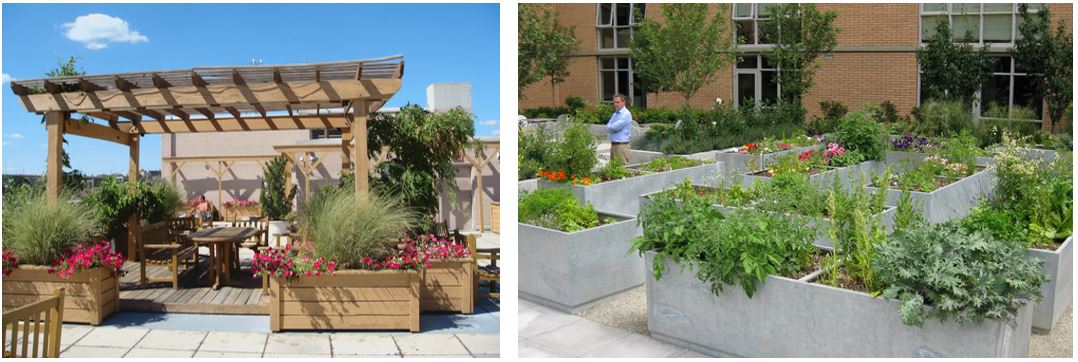
(3) Usable Commercial Open Space. New developments with nonresidential uses (except for development within the employment – industrial/office zone) on sites with a total site area greater than one-half acre must provide open space equal to at least two percent of the gross square footage of the development. The open space may be in the form of pedestrian-oriented space per subsection (4) of this section, garden, play area or other open space feature that serves both as a visual amenity and a place for human activity. Portions of sidewalks that are wider than 12 feet and which meet the standards of pedestrian-oriented space may be counted toward this requirement. For this specific standard, “site area” includes all land needed for the nonresidential portion of the project including parking, service areas, access and required landscaping. Nonresidential open space features must be approved by the reviewing authority.
Departure: Open space area may be reduced to one percent of the development envelope if the reviewing authority finds the project includes exceptional design features and elements that meet the purpose of the standards. This includes open spaces that feature a combination of design (site materials, amenities, and configuration) and location/context that clearly exceed typical plaza designs found in the region.
Figure 20.127.350(3)
Example Site Development Integrating Usable Commercial Open Space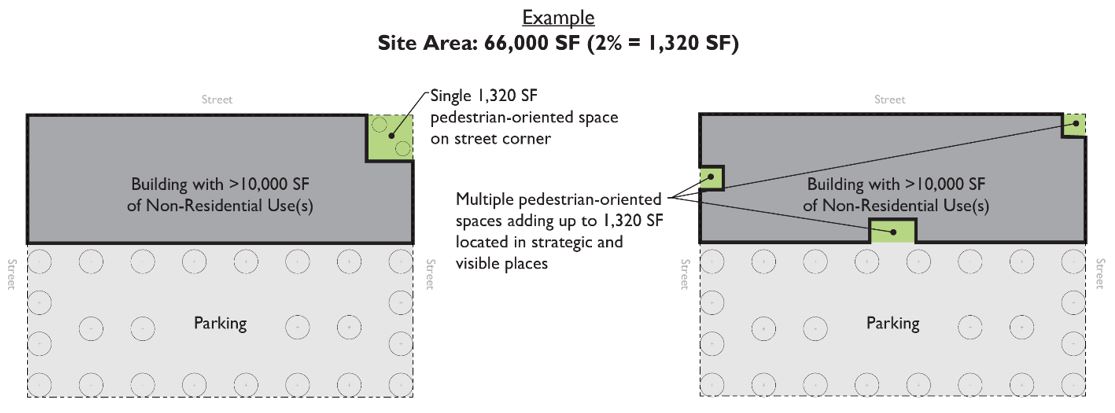
(4) Pedestrian-Oriented Space Design Criteria. This subsection describes the requirements and desired characteristics of pedestrian-oriented space (which may be used to meet the requirements of subsection (3) of this section).
(a) Required Pedestrian-Oriented Space Features.
(i) Visual and pedestrian access into the site from a street, private access road, or publicly accessible parking area.
(ii) Paved walking surfaces of either concrete or approved unit paving.
(iii) The spaces must be located in or adjacent to areas with significant pedestrian traffic to provide interest and security, such as adjacent to or visible from a building entry.
(iv) At least two linear feet of seating area (a bench or ledge at least 16 inches deep and appropriate seating height) or one individual seat per 60 square feet of plaza area or open space.
(v) Landscaping components that add visual interest and are not a visual barrier. This could include planting beds, raised planters, and/or potted plants.
(b) Desirable Pedestrian-Oriented Space Features.
(i) Pedestrian amenities, such as site furniture, lighting, artwork, drinking fountains, shade structures or other similar features.
(ii) Adjacent buildings with transparent windows and doors covering at least 50 percent of the facade between 30 inches and 10 feet above the ground level.
(iii) Pedestrian weather protection, alcoves, seating, or other features along building edges to allow for outdoor gathering.
(iv) Concrete or unit paving.
(c) Features Prohibited within a Pedestrian-Oriented Space.
(i) Asphalt pavement.
(ii) Adjacent service areas (e.g., trash areas) that are not separated with landscaping, as required in POMC 20.127.360, Location and design of service areas and mechanical equipment.
(iii) Adjacent chain-link fences.
(iv) Adjacent “blank walls” without “blank wall treatment” (see POMC 20.127.460(3)).
(v) Outdoor storage.
Figure 20.127.350(4)(i)
Example of Standards Applied to a Small Pedestrian-Oriented Space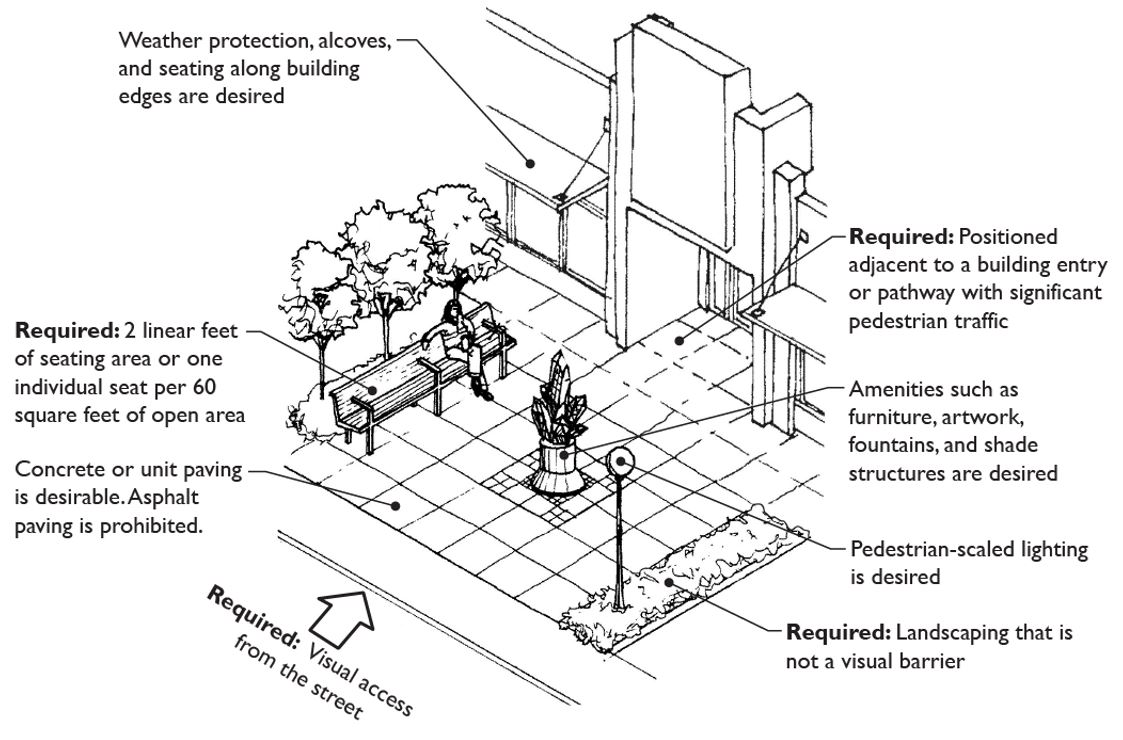
Figure 20.127.350(4)(ii)
Desirable Examples of Pedestrian-Oriented Space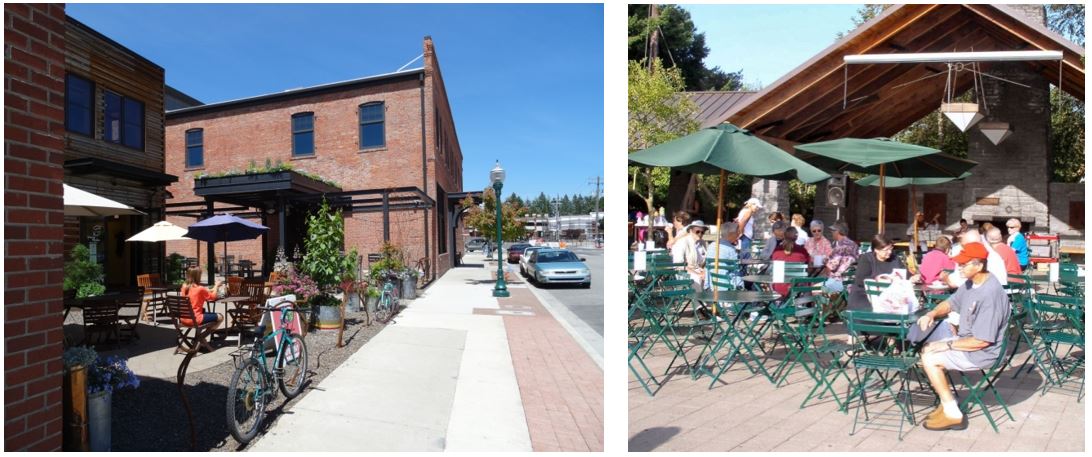
The left example above is a colorful plaza with outdoor seating, landscaping elements and direct access to adjacent retail uses. The upper right image is a commons area with adjacent covered areas.
A covered outdoor gathering space (left) may be used to meet pedestrian-oriented space requirements. In the right image, the widened sidewalk area may be counted as pedestrian-oriented space.
(5) Useable Mixed Use Open Space. Developments with a mix of residential and nonresidential uses may double-count useable open space for both residential units and commercial square footage, provided the double-counted open space meets the requirements of both subsections (2) and (3) of this section. (Ord. 008-18 § 2 (Exh. 1)).
20.127.360 Location and design of service areas and mechanical equipment.
(1) Purpose.
(a) To minimize adverse visual, odor, and noise impacts of mechanical equipment, utility cabinets and service areas at ground and roof levels.
(b) To provide adequate, durable, well-maintained, and accessible service and equipment areas.
(c) To protect residential uses and adjacent properties from impacts due to location and utilization of service areas.
(2) Location of Ground Related Service Areas and Mechanical Equipment.
(a) Service areas (loading docks, trash dumpsters, compactors, recycling areas, electrical panels, and mechanical equipment areas) must be located for convenient service access while avoiding negative visual, auditory, olfactory, or physical impacts on the streetscape environment and adjacent residentially zoned properties. Service areas must be sited for alley access if available.
The director and/or hearing examiner may require evidence that such elements will not significantly impact neighboring properties or public areas. (For example, noise damping specifications may be required for fans located near residential zones.)
(b) Exterior Loading Areas. Exterior loading areas for commercial uses must not be located within 20 feet of a single-family residentially zoned property.
Departure opportunity: Exterior commercial loading areas are exempt from this standard if the reviewing authority finds such a restriction does not allow feasible development and alternative design measures can successfully mitigate potential negative impacts. For example, areas and drives may be required to be separated from the residential lot by a masonry wall at least eight feet high.
(c) Service areas must not be visible from the sidewalk and adjacent properties. Where the reviewing authority finds that the only option for locating a service area is an area visible from a public right-of-way, resident/customer parking area, internal walkway or pedestrian area, or from an adjacent property, the area must be screened with structural and landscaping screening measures provided in subsection (3) of this section and Chapter 20.128 POMC, Development Standards – Landscaping.
Departure opportunity: Service elements accessible from an alley are exempt from screening requirements.
(d) Design for Safety. Other provisions of this section notwithstanding, service areas used by residents must be located to avoid entrapment areas and other conditions where personal security is potentially a problem. Pedestrian-scaled lighting or other measures may be required to enhance security.
(e) Locate and shield noise-producing mechanical equipment, such as fans, heat pumps, etc., to minimize sounds and reduce impacts to adjacent residentially zoned properties.
Figure 20.127.360(2)
Service Element Location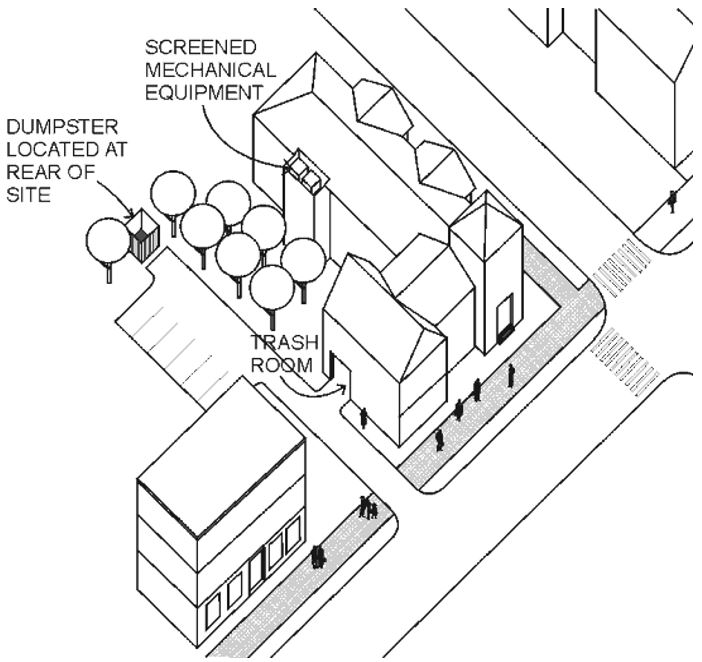
Locate service elements to reduce impacts on the residential and pedestrian environment, and provide appropriate enclosure.
(3) Screening of Ground Related Service Areas and Mechanical Equipment.
(a) Where screening of ground level service areas is called for (see subsection (2) of this section), adhere to the following:
(i) A structural enclosure must be constructed of masonry, heavy-gauge metal, or decay-resistant material that is also used with the architecture of the main building. The reviewing authority may allow materials other than those used for the main building if the finishes are similar in color and texture or if the proposed enclosure materials are more durable than those for the main structure. The walls must be sufficient to provide full screening from the affected roadway, pedestrian areas or adjacent use. The enclosure may use overlapping walls to screen dumpsters and other materials (see Figure 20.127.360(3) below).
(ii) Gates must be made of heavy-gauge, site-obscuring material. Chain link or chain link with slats is not an acceptable material for enclosures or gates.
(iii) Where the inside of service enclosures are visible from surrounding streets, walkways, and buildings, an opaque or semi-opaque horizontal cover or screen must be used to mitigate unsightly views. The horizontal screen/cover should be integrated into the enclosure design and compatible with adjacent development.
(iv) Collection points must be located and configured so that the enclosure gate swing does not obstruct pedestrian or vehicle traffic, or does not require that a hauling truck project into any public right-of-way. Ensure that screening elements allow for efficient service delivery and removal operations.
(v) The service area must be paved.
(b) The sides and rear of service enclosures must be screened with landscaping at least five feet wide in locations visible from the street, parking lots, and walkways to soften views of the screening element and add visual interest.
Departures from the provisions of subsections (3)(a) and (b) of this section will be considered provided the enclosure and landscaping treatment meet the purpose of the standards and add visual interest to site users.
Figure 20.127.360(3)
Acceptable Screening Enclosure
All three examples use durable and attractive enclosures with trees and shrubs to soften views of the enclosures from the side. The lower left example uses a trellis structure on top – a desirable example particularly where the top of the enclosures are visible from surrounding buildings, streets, and walkways (due to topography or building heights).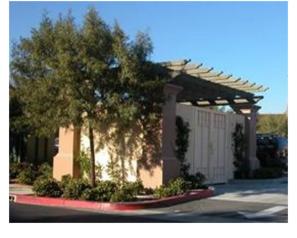
(4) Utility Meters, Electrical Conduit, and Other Service Utility Apparatus.
(a) These elements must be located and/or designed to minimize their visibility to the public. Project designers are strongly encouraged to coordinate with applicable service providers early in the design process to determine the best approach in meeting these standards. If such elements are mounted in a location visible from the street, pedestrian walkway, shared open space, or shared auto courtyards, they must be screened with vegetation and/or integrated into the building’s architecture.
Figure 20.127.360(4)
Utility Meter Location and Screening – Good and Bad Examples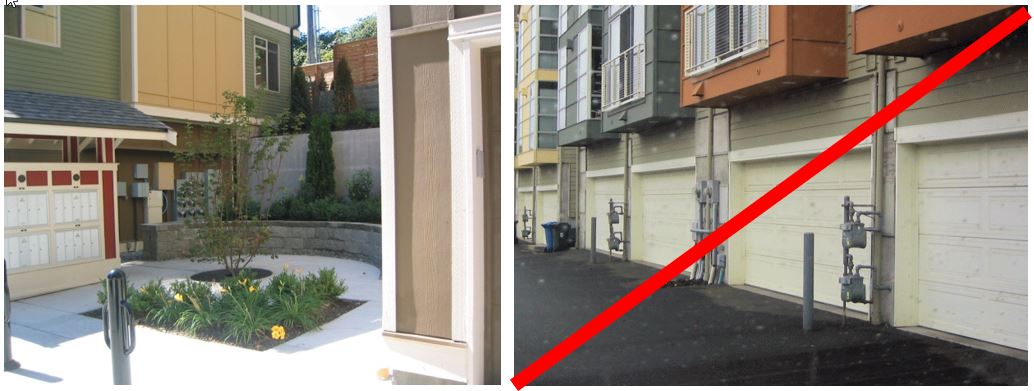
Place utility meters in less visible locations. The upper and lower left examples are successfully tucked away in a less visible location and/or screened by vegetation. The right images are poorly executed and would not be permitted in such visible locations. Such meters must be coordinated and better integrated with the architecture of the building.
(5) Location and Screening of Roof-Mounted Mechanical Equipment.
(a) All rooftop mechanical equipment, including air conditioners, heaters, vents, and similar equipment must be fully screened from public view both at grade and from higher buildings with the exception of solar panels and roof-mounted wind turbines. Screening must be located so as not to interfere with operation of the equipment.
(b) For rooftop equipment, all screening devices must be well integrated into the architectural design through such elements as parapet walls, false roofs, roof wells, clerestories, or equipment rooms. Screening walls or unit-mounted screening is allowed but less desirable. Wood must not be used for screens or enclosures. Louvered designs are acceptable if consistent with building design style. Perforated metal is not permitted.
(c) The screening materials must be of material requiring minimal maintenance, and must be as high as the equipment being screened.
(d) Locate and shield noise-producing mechanical equipment, such as fans, heat pumps, etc., to minimize sounds and reduce impacts to adjacent residentially zoned properties.
Figure 20.127.360(5)
Examples of How to Screen Roof-Mounted Mechanical Equipment
The examples above use walls to screen rooftop mechanical equipment from view from the street.
(Ord. 008-18 § 2 (Exh. 1)).
Article IV. Building Design Standards
20.127.400 Purpose.
See the individual “purpose” statements for each section in this article. (Ord. 008-18 § 2 (Exh. 1)).
20.127.410 Applicability and compliance.
(1) See POMC 20.127.020(1) for clarification on the types of development to which these standards apply.
(2) See POMC 20.127.020(2) for the relationship between the provisions in this article and other documents and codes.
(3) See POMC 20.127.020(3) for the application of building additions and remodels and site improvements. (Ord. 008-18 § 2 (Exh. 1)).
20.127.420 Building character.
(1) Purpose.
(a) To promote buildings with an architectural character that reflects the region’s aesthetic and is based on human scaled design details, durable high quality materials, sustainable design measures, and respond uniquely to the site’s context.
(b) To emphasize that high quality design is most critical to Port Orchard’s high visibility sites and corridors.
(c) To avoid generic, corporate architectural design that degrades the character and identity of Port Orchard.
(2) Corporate Architecture.
(a) Architecture that is defined predominately by corporate identity features and is difficult to adapt to other uses is prohibited. For example, some franchise convenience uses have very specific architectural features (such as a distinctive roofline design that functions as a sign) that reinforce their identity. As tenants change in these types of buildings, these corporate identity features can negatively impact the character of the area and identity of new tenants. These features can also be very expensive to reconfigure and adapt to new uses.
(b) Exemptions. This prohibition does not apply the Bravo Terrace and Sedgwick Road areas identified in Figure 20.127.420.
Figure 20.127.420
Areas Exempt from the Prohibition of Corporate Architecture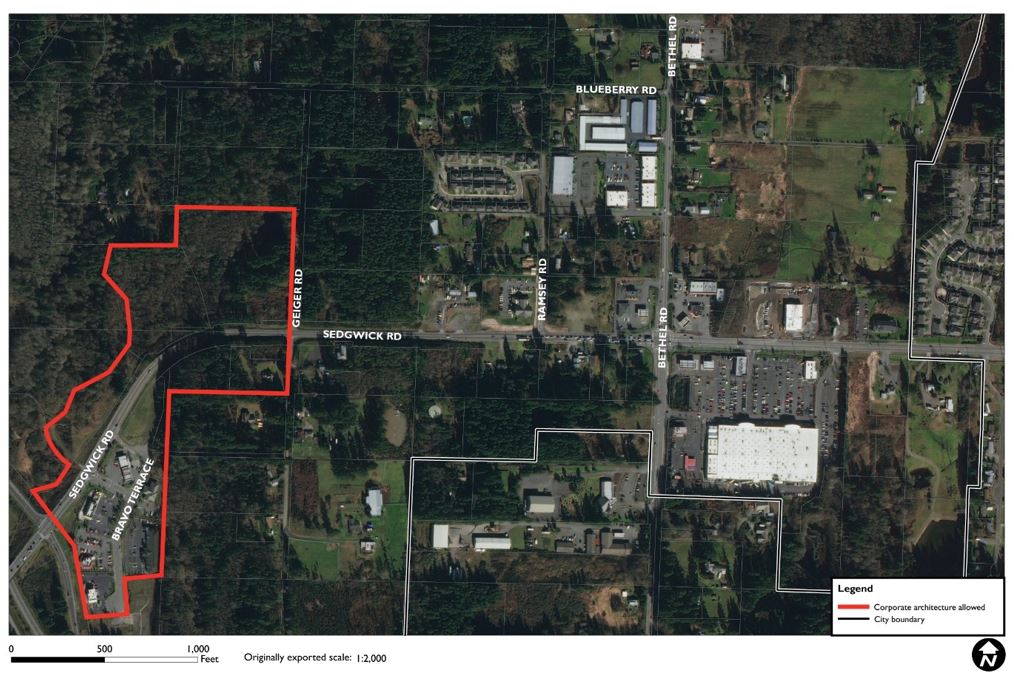
(Ord. 008-18 § 2 (Exh. 1)).
20.127.430 Building massing and articulation.
(1) Purpose.
(a) To employ facade articulation techniques that reduce the perceived scale of large buildings and add visual interest from all observable scales.
(b) To create clear and welcoming building entries.
(2) Facade Articulation – Nonresidential. Storefronts and other buildings with nonresidential uses on the ground level facade must include articulation features every 40 feet (maximum) to create a pattern of small storefronts. At least three of the following features must be employed at intervals no greater than 40 feet:
(a) Window patterns and/or entries.
(b) Use of weather protection features.
(c) Use of vertical piers/columns.
(d) Change in roofline per subsection (6) of this section.
(e) Change in building material or siding style.
(f) Other design techniques that effectively reinforce a pattern of small storefronts compatible with the building’s surrounding context.
Other features that could be used to meet the standards on block frontages that are not designated as storefront.
(g) Vertical elements such as a trellis with plants, green wall, art element.
(h) Providing vertical building modulation of at least 12 inches in depth if tied to a change in roofline per subsection (6) of this section or a change in building material, siding style, or color.
Departure: Other articulation features may be used provided they meet the purpose of the standards and the design criteria set forth in subsection (4) of this section.
Figure 20.127.430(2)
Facade Articulation Examples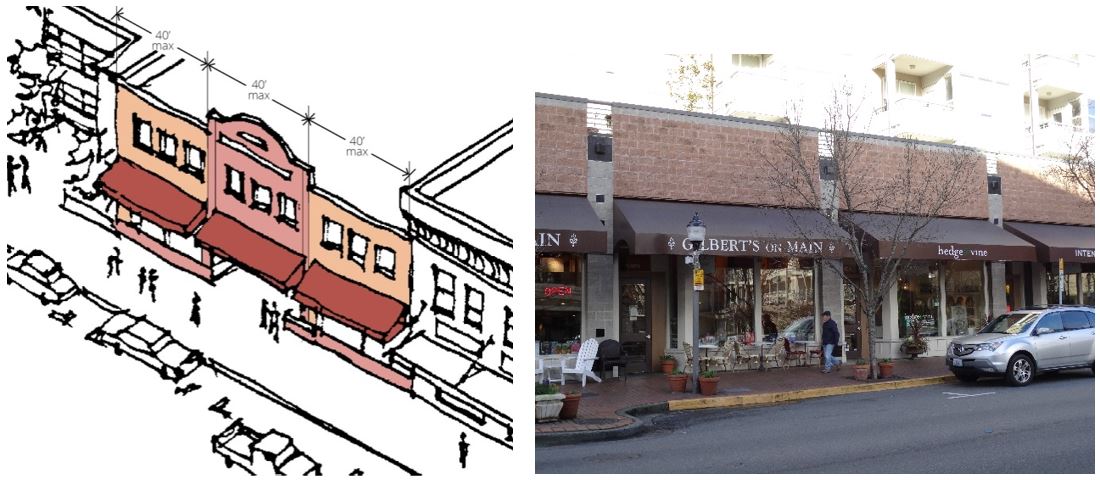
The left image uses window patterns, weather protection elements, and roofline modulation. The photo example to the right also includes window patterns and weather protection along with a change in masonry texture and color to articulate the facade. The lower example illustrates how a multitenant retail building can successfully be articulated (windows, weather protection, vertical building modulation, and roofline changes).
(3) Facade Articulation – Residential. Residential buildings must include articulation features at intervals that relate to the location/size of individual units within the building (or no more than every 30 feet) to break up the massing of the building and add visual interest and compatibility to the surrounding context. At least three of the following features must be employed at intervals no greater than the unit interval or 30 feet (whichever is less):
(a) Use of windows and/or entries.
(b) Change in roofline per subsection (6) of this section.
(c) Change in building material, siding style, and/or window pattern.
(d) Providing vertical building modulation of at least 12 inches in depth if tied to a change in roofline modulation per subsection (6) of this section or a change in building material, siding style, or color. Balconies may be used to qualify for this option if they are recessed or projected from the facade by at least 18 inches. Juliet balconies or other balconies that appear to be tacked on to the facade will not qualify for this option unless they employ high quality materials and effectively meet the purpose of the standards.
(e) Vertical elements such as a trellis with plants, green wall, art element.
(f) Other design techniques that effectively break up the massing at no more than 30-foot intervals.
Departures: Other articulation features will be considered provided they meet the purpose of the standards and the design criteria set forth in subsection (4) of this section.
Figure 20.127.430(3)
Residential Facade Articulation Examples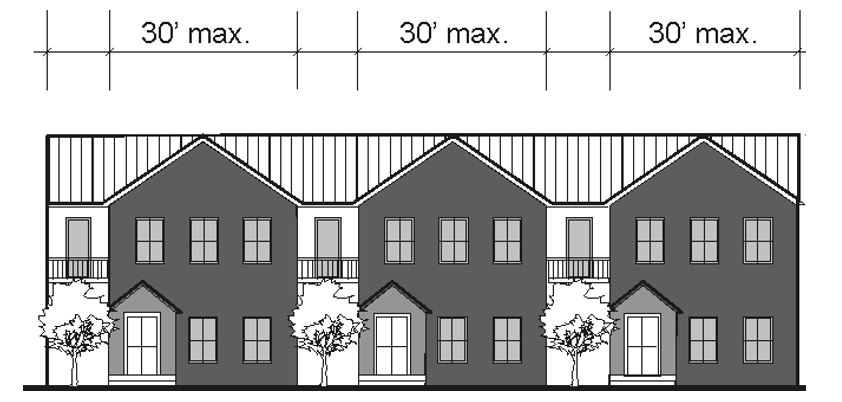
Below examples use a combination of vertical building modulation, window patterns, material changes, and roofline modulation.
(4) Departure Criteria Associated with Articulation Standards. Proposals must meet the purpose of the standards. The following criteria will be considered in determining whether the proposed articulation treatment meets the “purpose.”
(a) Consider the type and width of the proposed articulation treatment and how effective it is in meeting the purpose given the building’s current and desired context (per Port Orchard’s comprehensive plan or applicable adopted subarea plan).
(b) Consider the applicable block frontage designation. Undesignated block frontages warrant more flexibility than block frontages designated as varied or landscaped.
(c) Consider the size and width of the building. Smaller buildings warrant greater flexibility than larger buildings.
(d) Consider the quality of facade materials in concert with doors, windows, and other facade features and their ability to add visual interest to the street from a pedestrian scale and more distant observable scales.
Figure 20.127.430(4)
Facade Articulation Departure Examples
This building would be a good departure example. Its two clear articulation features are the window patterns and the entry/building modulation feature (three minimum are required). However, the overall effectiveness of these articulation features combined with the high quality of materials and detailing and the relatively small width of the building help it meet the purpose of the standards.
(5) Maximum Facade Width. For most buildings, small scale articulation techniques (see subsections (2) and (3) of this section) are sufficient to reduce the perceived scale of buildings, add visual interest, and contribute to the pedestrian environment. Larger buildings need more substantial articulated/modulated features to break up the massing and add visual interest.
Building facades wider than 100 feet must include at least one of the following features to break up the massing of the building and add visual interest. Building walls facing alleys, rear or side yards are not subject to the standards herein, except for zone edge properties, when adjacent to a lower intensity zoning district.
(a) Provide vertical building modulation at least 20 feet deep and 30 feet wide. For multi-story buildings, the modulation must extend through more than one-half of the building floors.
(b) Use of a contrasting vertical modulated design component featuring all of the following:
(i) Component extends through all floors above the first floor fronting on the street. Exception: upper floors that are set back more than 10 feet horizontally from the facade are exempt.
(ii) Utilizes a change in building materials that effectively contrasts with the rest of the facade.
(iii) Component is modulated vertically from the rest of the facade by an average of six inches.
(iv) Component is designed to provide roofline modulation per subsection (6) of this section.
(c) Facade employs building walls with contrasting articulation that make it appear like two distinct buildings. To qualify for this option, these contrasting facades must employ all of the following:
(i) Different building materials and/or configuration of building materials.
(ii) Contrasting window design (sizes or configurations).
(d) Departures will be considered provided the design meets the purpose of the standards. Supplemental consideration for approving alternative designs:
(i) Width of the Facade. The larger the facade, the more substantial articulation/ modulation features need to be.
(ii) Block Frontage Designation. Storefront designated block frontages warrant the most scrutiny while undesignated streets warrant more flexibility.
(iii) The type of articulation treatment and how effective it is in meeting the purpose given the building’s context.
Figure 20.127.430(5)(i)
Illustrating Maximum Facade Width Standards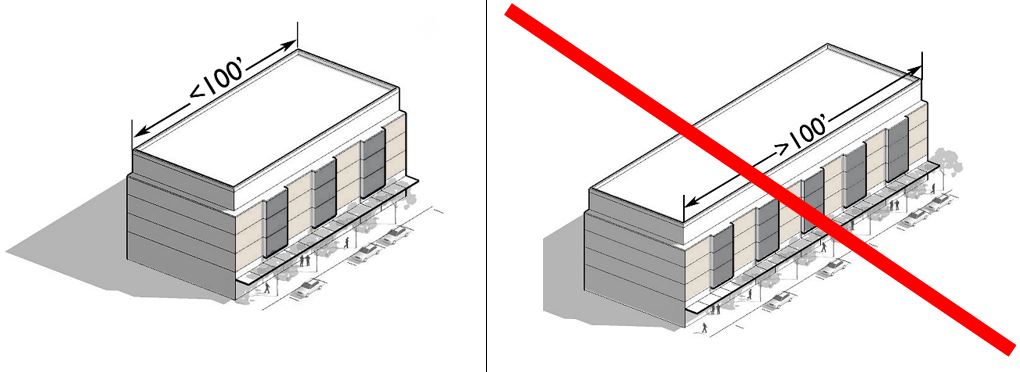
Less than 100 feet wide: meets standard. More than 100 feet wide: does not meet standard.
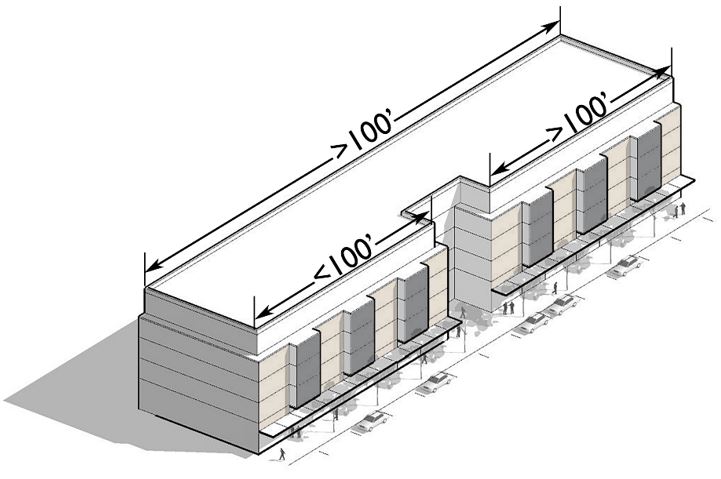 Building incorporates a 20-foot by 30-foot courtyard along the facade to effectively break it up into smaller components: meets standard.
Building incorporates a 20-foot by 30-foot courtyard along the facade to effectively break it up into smaller components: meets standard.
Figure 20.127.430(5)(ii)
Facade Width Good and Bad Examples
Both buildings use modulated entry features to help break up the perceived massing and add visual interest.
The left building (about 110 feet wide) uses an articulated partial third floor along with smaller articulation treatments on the main floors to effectively break up the perceived scale and add visual interest (this would be a good departure example). The building to the right would not be an acceptable example. While the articulated features on the lower floors help, the monotony of the very long upper floor and roofline would not be acceptable.
(6) Roofline Modulation. In order to qualify as a facade articulation feature in subsections (2), (3), and (5) of this section, rooflines must employ one or more of the following:
(a) For flat roofs or facades with horizontal eave, fascia, or parapet, the minimum vertical dimension of roofline modulation is the greater of two feet or 0.1 multiplied by the wall height (finish grade to top of the wall) when combined with vertical building modulation techniques described in subsections above. Otherwise, the minimum vertical dimension of roofline modulation is the greater of four feet or 0.2 multiplied by the wall height.
(b) A pitched roofline or gabled roofline segment of at least 20 feet in width. Buildings with pitched roofs must include a minimum slope of 5:12 and feature modulated roofline components at the interval required per the applicable standard above.
(c) A combination of the above.
Departures: Other designs will be considered provided the roofline modulation design effectively reduces the perceived scale of the building and adds visual interest.
Figure 20.127.430(6)
Acceptable Examples of Roofline Modulation
Roofline modulation examples for flat roofs.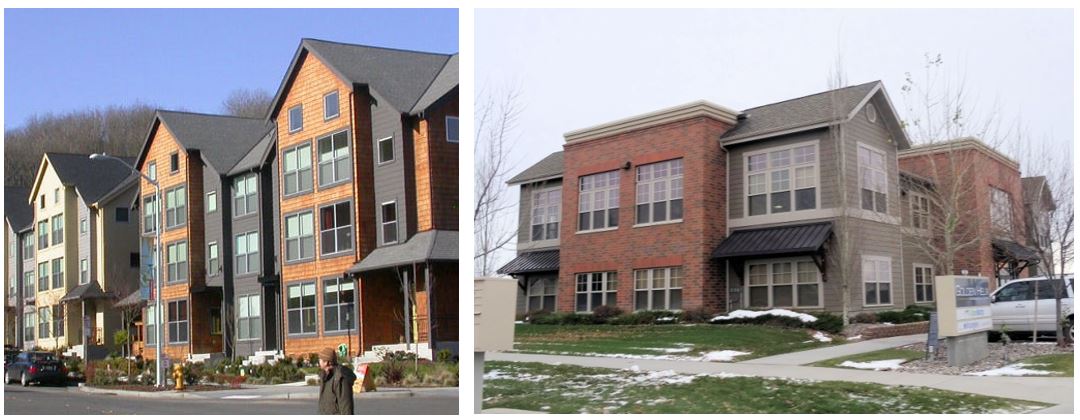
The bottom left building illustrates a pitched roof example and the bottom right building includes a combination of flat and gabled rooflines.
(Ord. 008-18 § 2 (Exh. 1)).
20.127.440 Building details.
(1) Purpose.
(a) To encourage the incorporation of design details and small scale elements into building facades that are attractive at a pedestrian scale.
(b) To integrate window design that adds depth, richness, and visual interest to the facade.
(2) Facade Details – Nonresidential and Mixed Use Buildings. All commercial and mixed use buildings must be enhanced with appropriate details. All new buildings and additions associated with Level II and III improvements (see POMC 20.127.020) must employ at least one detail element from each of the three categories below for each facade articulation interval (see POMC 20.127.430).
For example, a building with 120 feet of street frontage with a facade articulated at 40-foot intervals will need to meet the standards for each of the three facade segments below.
(a) At least one window and/or entry treatment, such as the following, must be employed for each articulation interval:
(i) Display windows divided into a grid of multiple panes.
(ii) Transom windows.
(iii) Roll-up windows/doors.
(iv) Other distinctive window treatment that meets the purpose of the standards.
(v) Recessed entry.
(vi) Decorative door.
(vii) Other decorative or specially designed entry treatment that meets the purpose of the standards.
Figure 20.127.440(2)(a)
Examples of Decorative or Specially Designed Windows and Entries
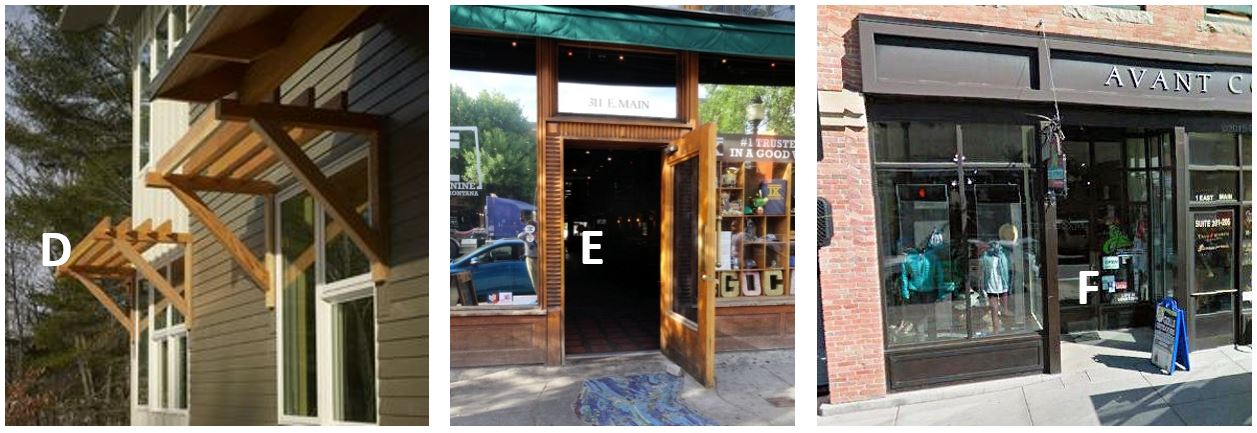
Examples of decorative or specially designed windows and entries. A = openable storefront window. B = transom windows. C = openable window with decorative details. D = decorative window shades. E = decorative door. F = recessed entry.
(b) At least one building element or facade detail, such as the following, must be employed for each articulation interval:
(i) Custom-designed weather protection element such as a steel canopy, cloth awning, or retractable awning.
(ii) Decorative building-mounted light fixtures.
(iii) Bay windows, trellises, towers, and similar elements.
(iv) Decorative, custom hanging sign(s) (option only available for building remodels).
(v) Other details or elements that meet the purpose of these standards.
Figure 20.127.440(2)(b) Examples of Attached Elements That Enhance the Visual Intrigue of the Building
Examples of Attached Elements That Enhance the Visual Intrigue of the Building
Examples of elements attached to facade that enhance the visual intrigue of the building. A = retractable awning. B = custom hanging bike rack and repair station integrated as a storefront design element. C = decorative facade/sign lighting. D and E = custom decorative canopy. F = decorative tower.
(c) At least one building material and other facade element, such as the following, must be employed for each articulation interval:
(i) Use of decorative building materials/use of building materials. Examples include decorative use of brick, tile, or stonework.
(ii) Artwork on building, such as a mural or bas-relief sculpture.
(iii) Decorative kick-plate, pilaster, base panel, or other similar feature.
(iv) Hand-crafted material, such as special wrought iron or carved wood.
(v) Other details that meet the purpose of the standards.
“Custom,” “decorative,” or “hand-crafted” elements referenced above must be distinctive or “one-of-a-kind” elements or unusual designs that require a high level of craftsmanship.
Departures will be considered provided the facade (at the overall scale and at the individual articulation scale) meets the purpose of the standards above.
Figure 20.127.440(2)(c)
Examples of Decorative Surface Materials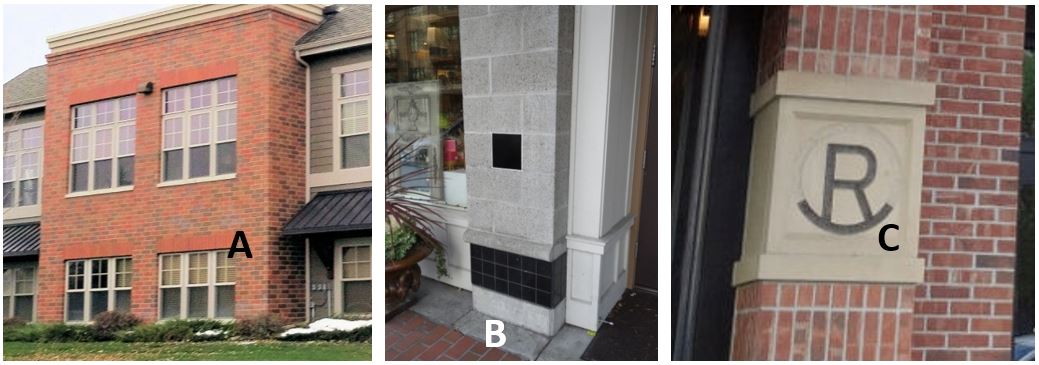
Examples of decorative surface materials. A = decorative brick/design. B = decorative tile-work and column pattern. C = decorative medallion.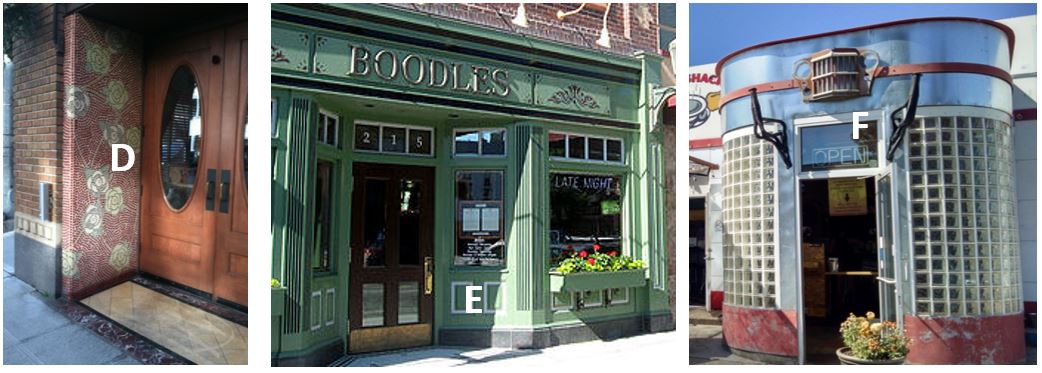
D = decorative mosaic tile work. E = decorative bulkhead. F = decorative materials and design.
(3) Window Design Standards. All windows (except storefront display windows) must employ designs that add depth and richness to the facade. At least one of the following features must be included to meet this requirement:
(a) Recess windows at least two inches from the facade.
(b) Incorporate window trim (at least three inches wide) around windows.
(c) Incorporate other design treatments that add depth, richness, and visual interest to the facade.
Departures from the window standards above will be considered provided the design meets the purpose of the standards.
Figure 20.127.440(3)
Acceptable and Unacceptable Window Design Examples
Recessed and/or trimmed windows above.
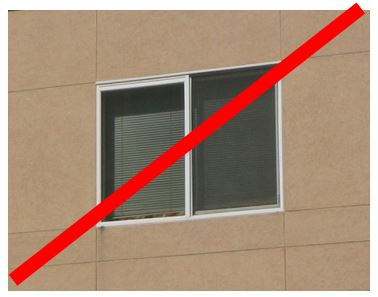 The window in the left image lacks any other detail that adds visual interest. However, the right example, with its prominent black sash and muntins and frieze/apron details above and below the windows would be acceptable departure design.
The window in the left image lacks any other detail that adds visual interest. However, the right example, with its prominent black sash and muntins and frieze/apron details above and below the windows would be acceptable departure design.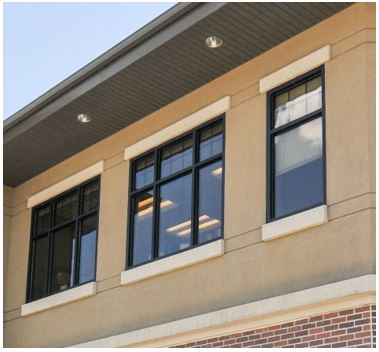
(4) Cornice/Roofline Design for Flat Roofs. Nonresidential and mixed use buildings employing a flat roof must employ a distinctive roofline that effectively provides an identifiable “top” to the building, including one of the following (Figure 20.127.440(4) below illustrates acceptable and unacceptable examples):
(a) A traditional cornice line or a contemporary interpretation of a traditional cornice line. Such rooflines must be proportional to the size and scale of the building.
(b) Understated cornice lines are permitted depending on the materials and design of the base and middle elements in reinforcing the base/middle/top configuration.
Rooftop solar units are permitted, provided the placement and design of units visible from the surrounding streetscape are carefully integrated into the overall design concept of the building.
Departure: Alternative roofline designs may be acceptable provided the building design, collectively, meets the purpose of the standards. For example, adding additional articulation treatments and/or detailing may help the building meet the departure criteria.
Figure 20.127.440(4)
Examples of Buildings Employing Confident and Distinctive Rooflines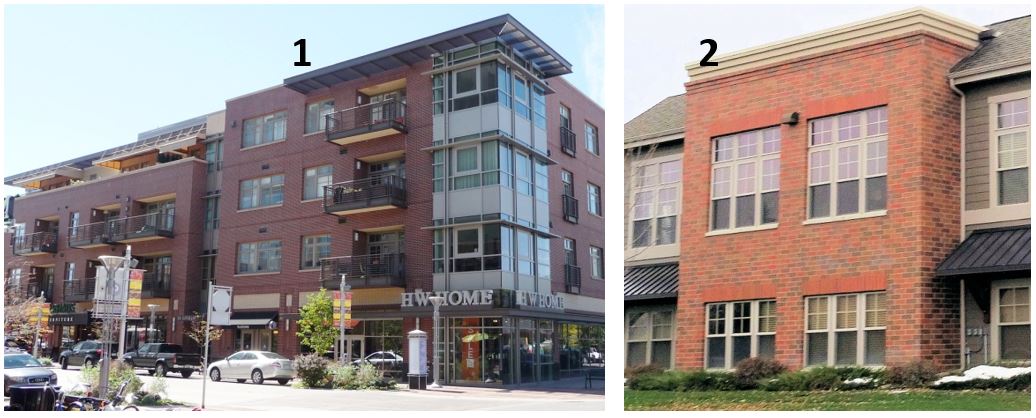
Building 1 uses a dramatic overhanging cornice at the corner. The left portion of building 1 uses a very simple cornice line – to go with the upper level setback. Building 2 uses a traditional cornice line.
Building 3 uses capped projecting columns along with an understated cornice line. Building 4 uses a very simple roofline – which is acceptable in this case due to the prominence of the wooden canopy.
(5) Articulated Building Entries. The primary building entrance for an office building, hotel, apartment building, public or community-based facility or other multi-story commercial building must be designed as a clearly defined and demarcated standout architectural feature of the building. Such entrances must be easily distinguishable from regular storefront entrances on the building. Such entries must be scaled proportional to the building. See Figure 20.127.440(5) below for good examples.
Figure 20.127.440(5)
Acceptable Building Entry Examples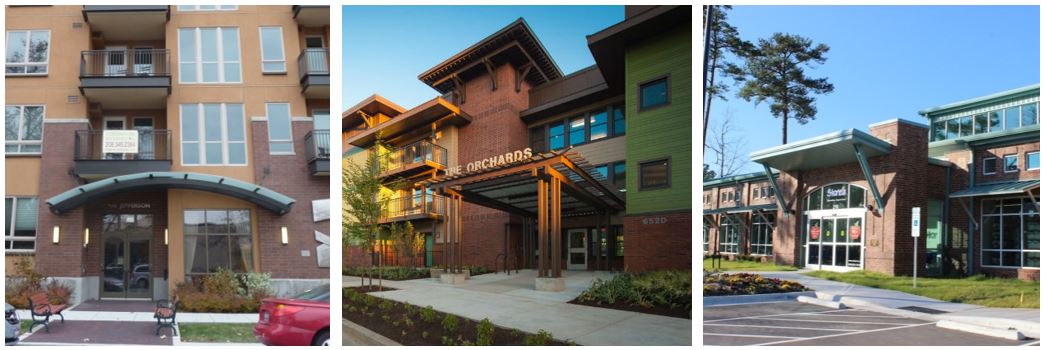
(Ord. 008-18 § 2 (Exh. 1)).
20.127.450 Building materials.
(1) Purpose.
(a) To encourage the use of durable, high quality, and urban building materials that minimize maintenance cost and provide visual interest from all observable vantage points.
(b) To promote the use of a distinctive mix of materials that helps to articulate facades and lends a sense of depth and richness to the buildings.
(c) To place the highest priority on the first floor in the quality and detailing of materials at the pedestrian scale.
(2) Quality Building Materials. Applicants must use high quality durable materials. This is most important for the base of buildings, particularly for commercial and mixed use buildings where the facade is sited close to sidewalks. At a minimum, stone, brick or tile masonry, or architectural concrete (first two feet only) must be used (excluding window and door areas) for the first floor of cladding on nonresidential or mixed use buildings and the first two feet of residential buildings.
(3) Special Conditions and Limitations for Concrete Block (Also Known as Concrete Masonry Unit or CMU). Concrete block may be used as a cladding material if it is incorporated with other permitted materials and/or incorporates a combination of textures and/or colors to add visual interest. For example, combining split or rock-facade units with smooth blocks can create distinctive patterns. The figure below illustrates acceptable concrete block use/designs.
Figure 20.127.450(3)
Acceptable Concrete Block Use/Design
CMU is the primary cladding for the corner element above, but secondary to brick on the main facades. The corner element uses a combination of decorative split-faced CMU closer to the sidewalk and smooth-faced CMU that is colored to look more like traditional white terra cotta tiles.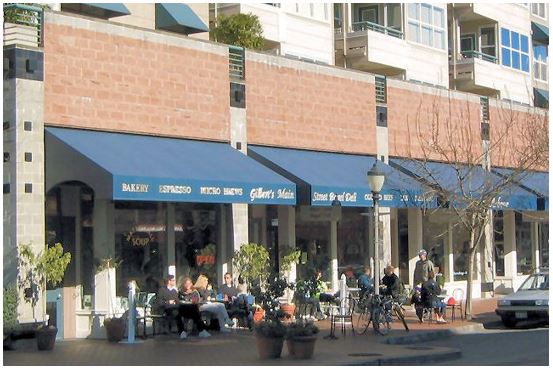
The above facade illustrates an acceptable alternative example, as CMU is used as the primary cladding material. Note the use of split-facade CMUs above each of the awnings and coupled with the use of smooth-facade CMUs on the vertical columns (which employ black accent tiles for added interest).
(4) Special Conditions and Limitations for Metal Siding. Metal siding may be used as a secondary cladding material if it is incorporated with other permitted materials and complies with the following standards:
(a) It must feature visible corner molding and trim and must not extend lower than two feet above grade. Masonry, concrete, or other durable material must be incorporated between the metal siding and the ground plane.
(b) Metal siding must be factory finished with a matte, nonreflective surface.
(c) Use of at least two colors of metal siding on the facade is encouraged but not required.
Departures: Other designs will be considered provided the material’s integration and overall facade composition meets the purpose of the standards.
Figure 20.127.450(4)
Acceptable Metal Siding Examples
The use of metal siding in each example above is secondary to masonry. The left and right images are more contemporary in character, whereas the middle image is more rustic and industrial, with more refined windows.
(5) Special Conditions and Limitations for the Use of Exterior Insulation and Finish System (EIFS). Such material/finishes may be used as a decorative accent cladding material if incorporated with other permitted materials and compliant with the following:
(a) EIFS is limited to no more than 20 percent of the total facade area and may not be the primary cladding material.
(b) EIFS must feature a smooth or sand finish only.
(c) EIFS must be trimmed in wood, masonry, or other material and must be sheltered from weather by roof overhangs or other methods.
(d) EIFS must not extend lower than eight feet above grade. Concrete, masonry, or other durable material must be used for ground level wall surfaces to provide a durable surface where damage is most likely.
Departures to allow up to 50 percent coverage of the facade and other design treatments will be considered provided the material’s integration and overall facade composition meets the purpose of the standards.
Figure 20.127.450(5)
Acceptable and Unacceptable EIFS Examples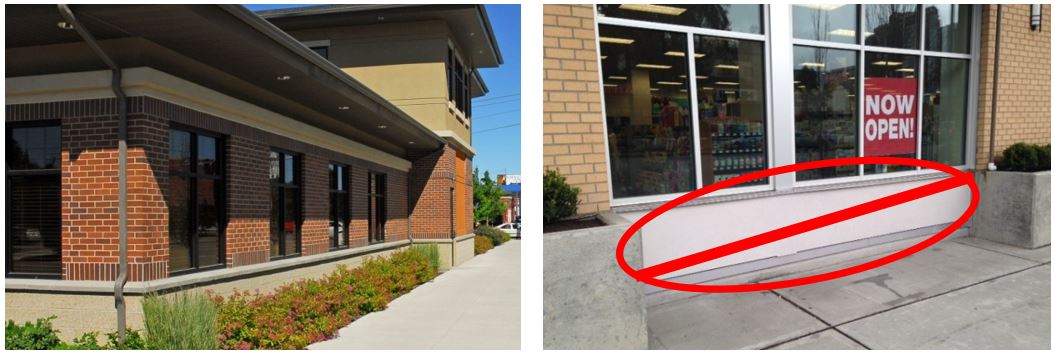
Note the use of brick and decorative concrete block on the ground level and EIFS on the second floor of the left image. The window treatments visible on the second floor add depth and interest to the facade. The right image employs EIFS between the window and sidewalk – this design is prohibited.
(6) Special Conditions and Limitations for Cementitious Wall Board Paneling/Siding. Such material may be used provided it meets the following provisions:
(a) Cement board paneling/siding may not be used on the ground floor of nonresidential or mixed use buildings where adjacent to a sidewalk or other pedestrian path.
(b) Where cement board paneling/siding is the dominant siding material, the design must integrate a mix of colors and/or textures that are articulated consistent with windows, balconies, and modulated building surfaces and are balanced with facade details that add visual interest from the ground level and adjacent buildings.
Departures: Other designs will be considered provided the material’s integration and overall facade composition meets the purpose of the standards.
Figure 20.127.450(6)
Acceptable and Unacceptable Cementitious Wall Board Examples.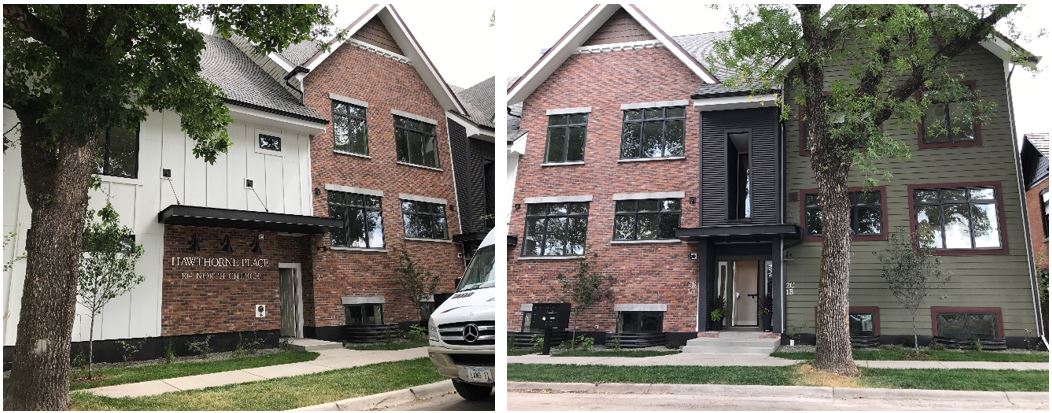
The above building uses cementitious wall board in different textures and colors to help articulate the facade. The white color replicates the board and batten style in the left image and green color in the right image effectively replicates horizontal wood siding.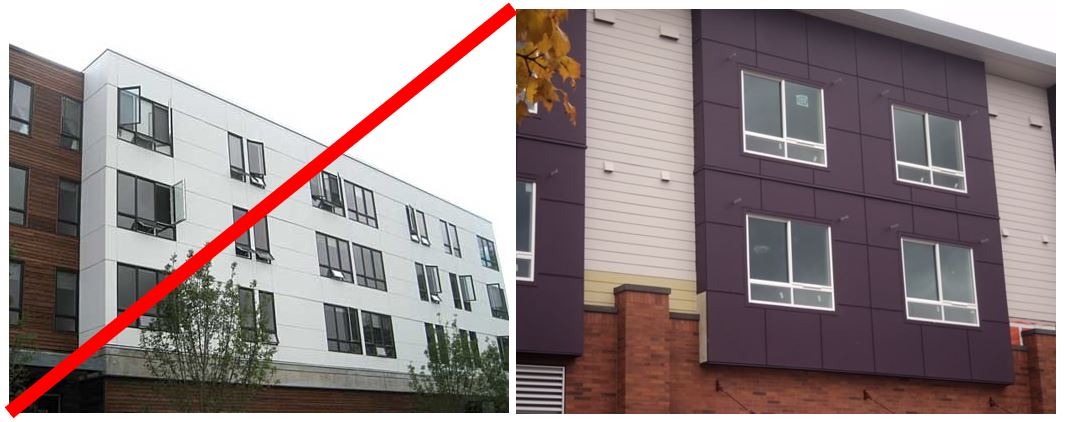
The wall board panels covering a large area in a single color would not meet the purpose of the standards. The right image is a better example and combines larger panels (dark maroon color) with horizontal wall board siding (beige color) as effective articulation features. Below is a similar acceptable example.

Another acceptable wall board example replicating board and batten style with horizontal siding integrated with different colors and roofline modulation.
(Ord. 008-18 § 2 (Exh. 1)).
20.127.460 Blank wall treatments.
(1) Purpose.
(a) To avoid untreated blank walls.
(b) To retain and enhance the character of Port Orchard’s streetscapes.
(2) Blank Wall Definition. A wall (including building facades and retaining walls) is considered a blank wall if it is over 10 feet in height, has a horizontal length greater than 15 feet, and does not include a transparent window or door.
Figure 20.127.460(2)
Blank Wall Definition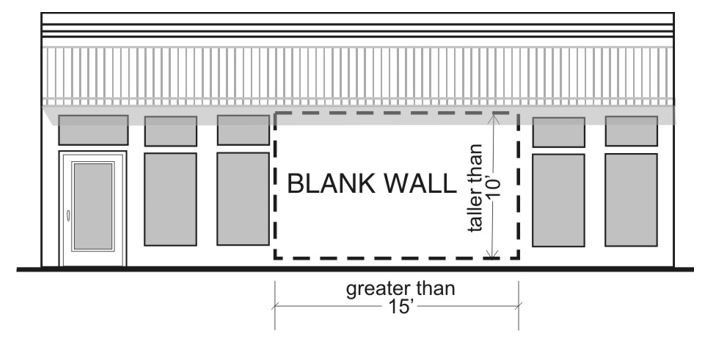
(3) Untreated blank walls visible from a public street, pedestrian-oriented space, common usable open space, or pedestrian walkway are prohibited. Methods to treat blank walls can include:
(a) Display windows at least 16 inches of depth to allow for changeable displays. Tack on display cases do not qualify as a blank wall treatment.
(b) Landscape planting bed at least five feet wide or a raised planter bed at least two feet high and three feet wide in front of the wall with planting materials that are sufficient to obscure or screen at least 60 percent of the wall’s surface within three years.
(c) Installing a vertical trellis in front of the wall with climbing vines or plant materials.
(d) Installing a mural as approved by the reviewing authority.
(e) Special building detailing that adds visual interest at a pedestrian scale. Such detailing must use a variety of surfaces; monotonous designs will not meet the purpose of the standards.
For large visible blank walls, a variety of treatments may be required to meet the purpose of the standards.
Figure 20.127.460(3)
Acceptable and Unacceptable Blank Wall Treatments
The left image illustrates that heavy landscaping can be very effective in treating a large blank wall. The building in the middle image uses a combination of planted trellises and display ads integrated with the building’s architecture along a facade facing a drive-through. The example in the right image simply doesn’t use enough treatments and the result is a stark and unwelcome streetscape.
(Ord. 008-18 § 2 (Exh. 1)).



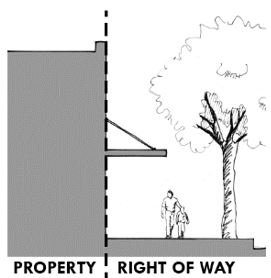
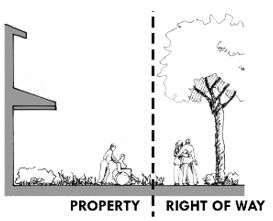
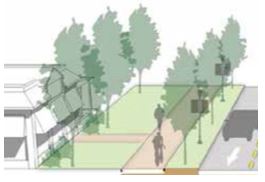
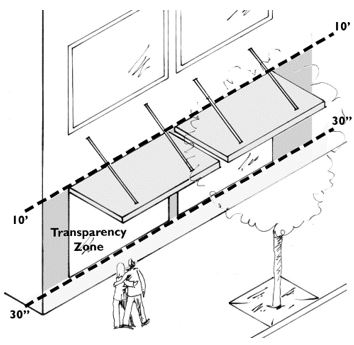
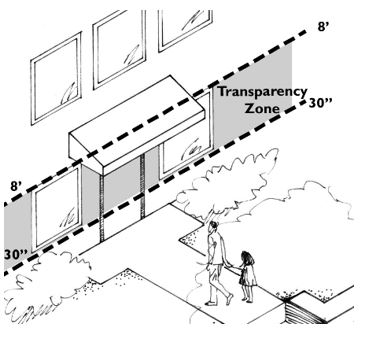
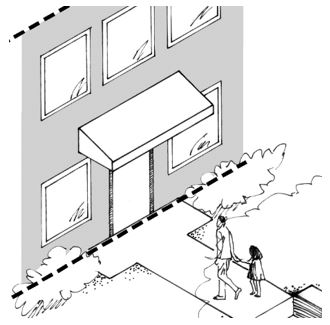
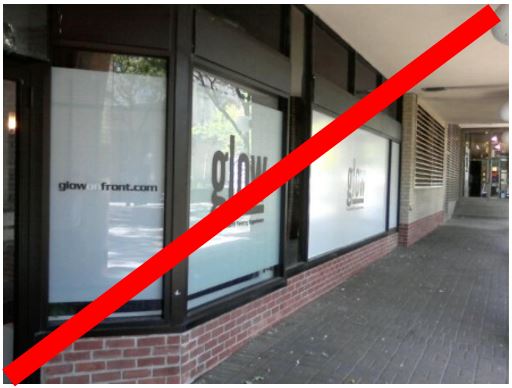
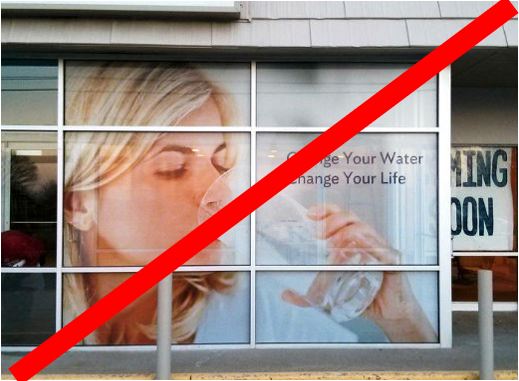


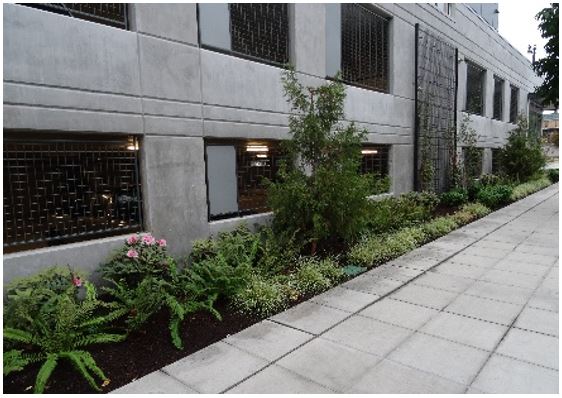

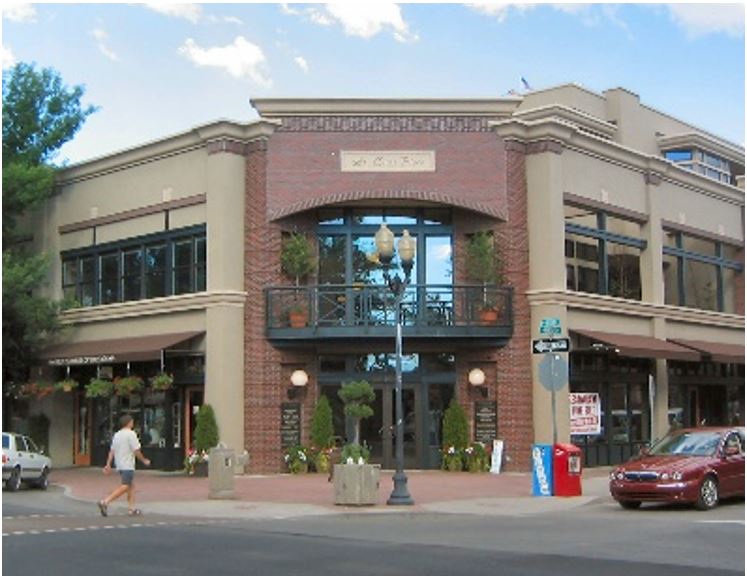
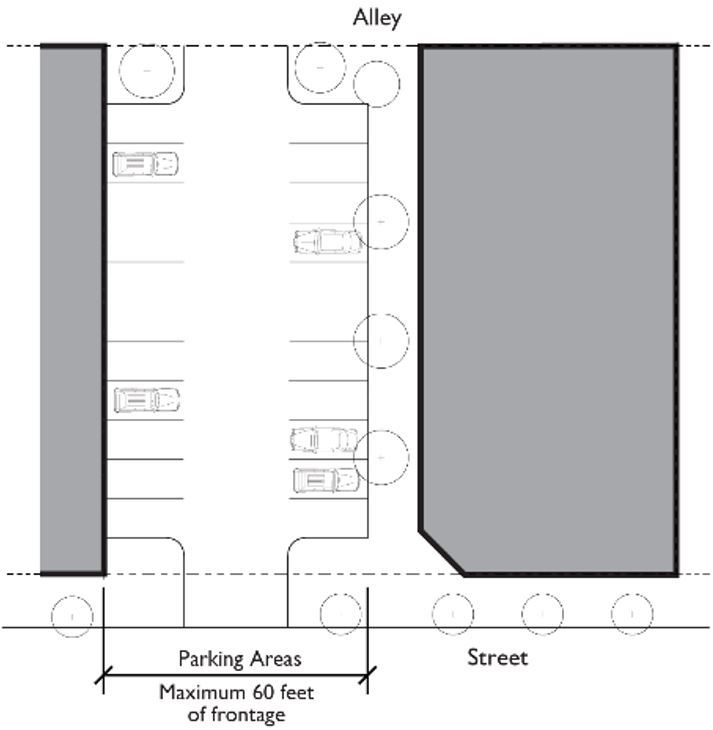
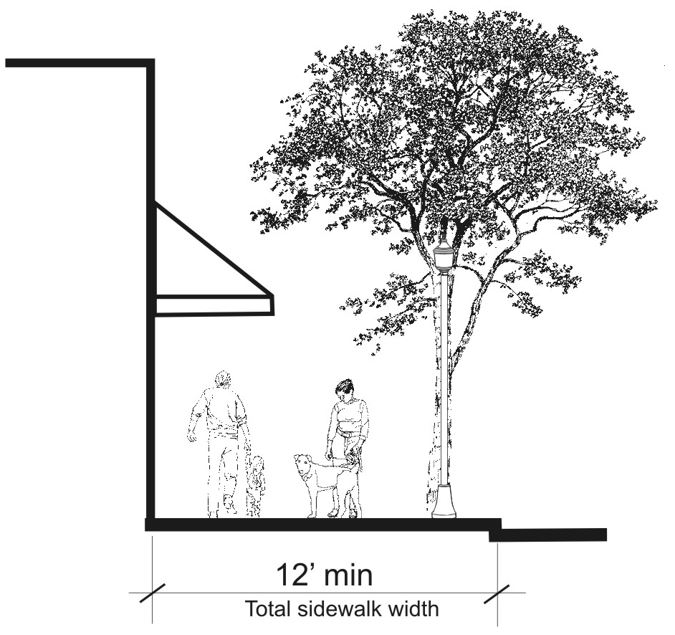
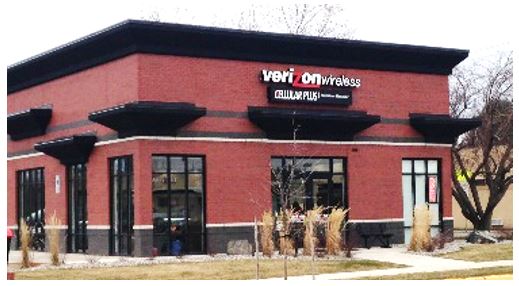
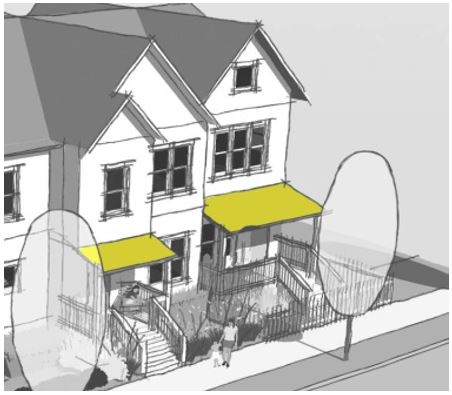

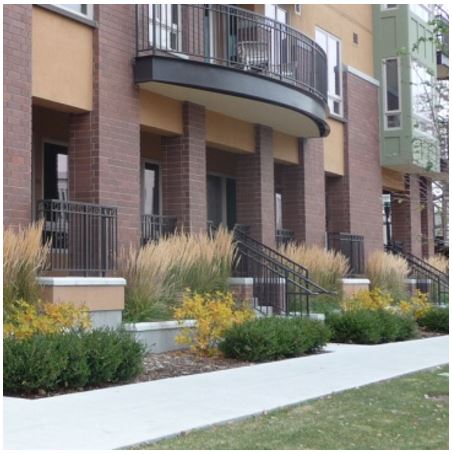 Example of low level landscaping that screens foundation walls, provides visual interest, and maintains views from dwelling units to the street.
Example of low level landscaping that screens foundation walls, provides visual interest, and maintains views from dwelling units to the street.